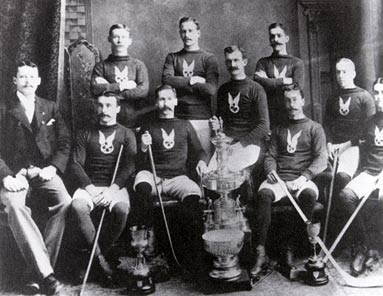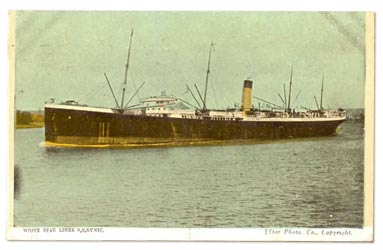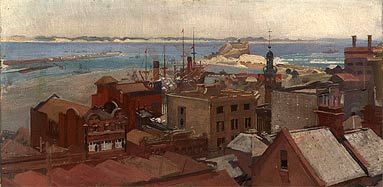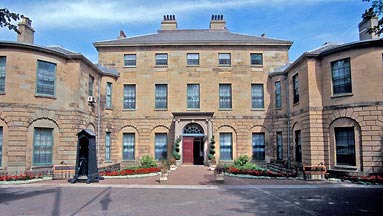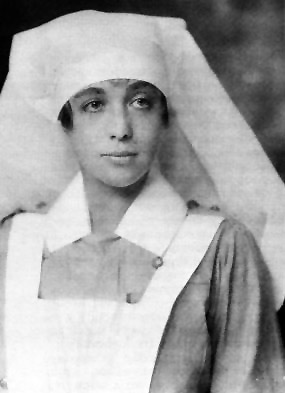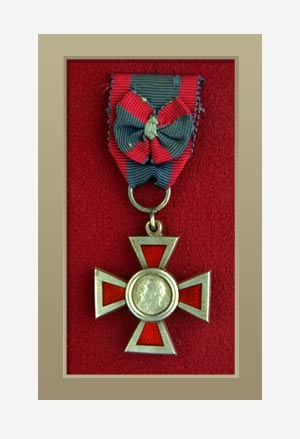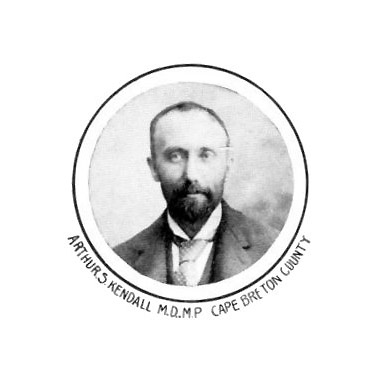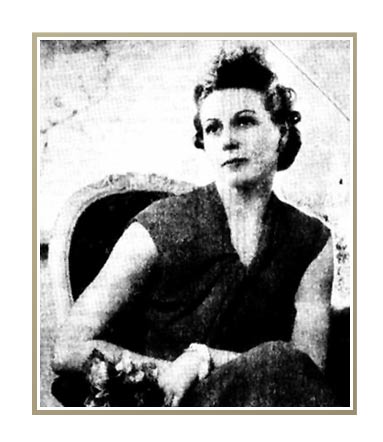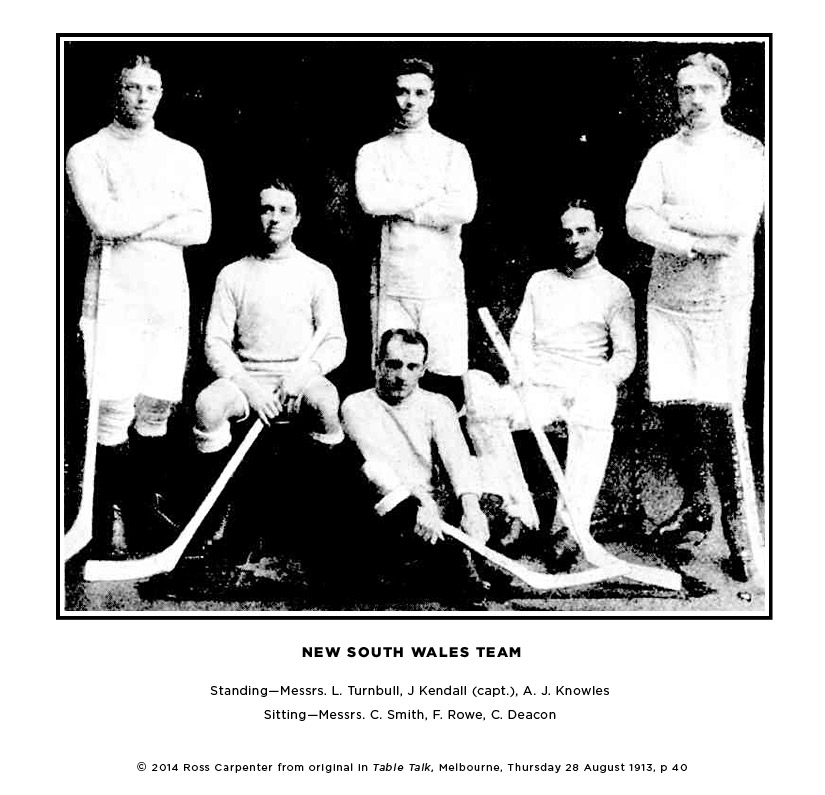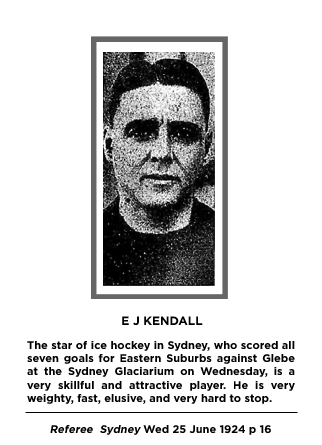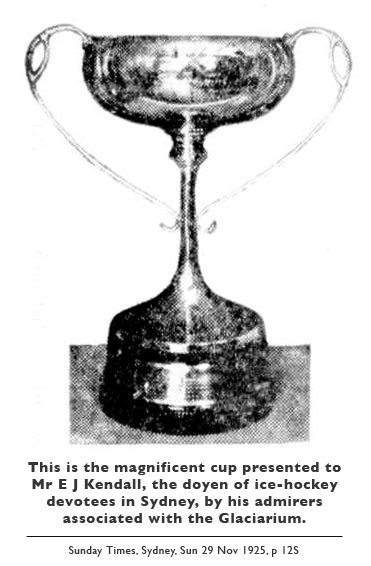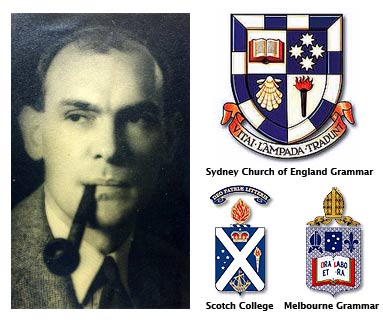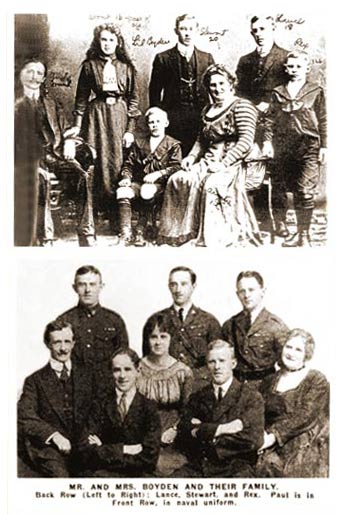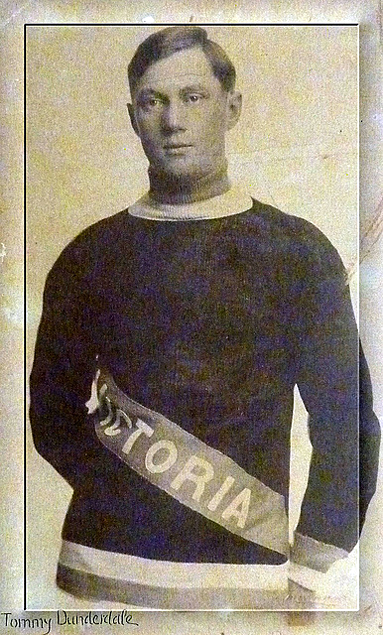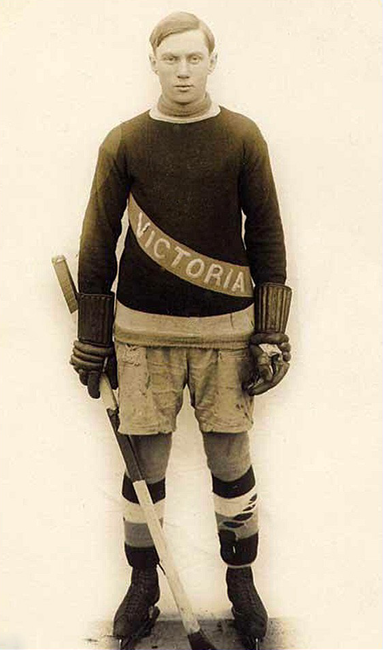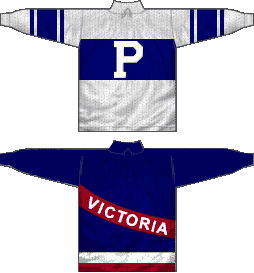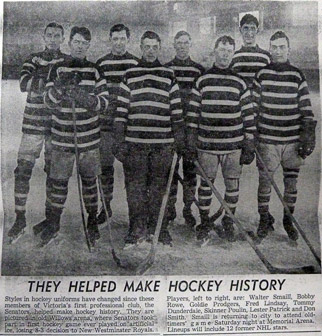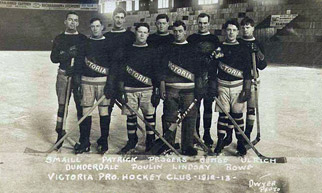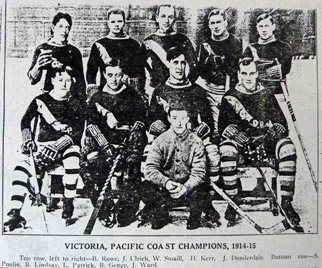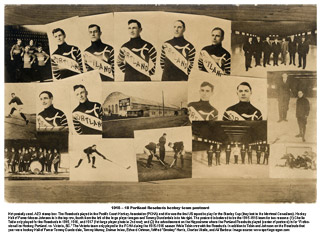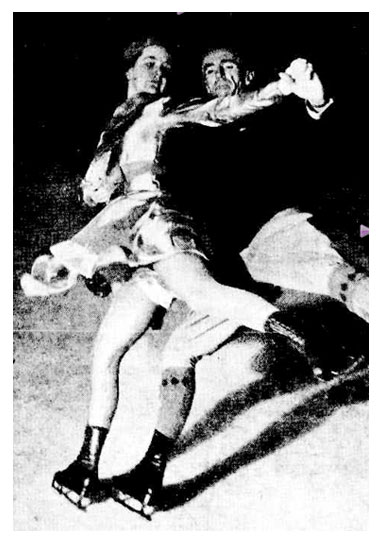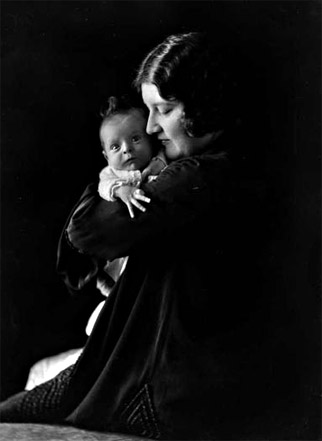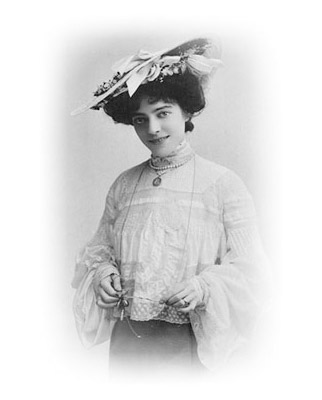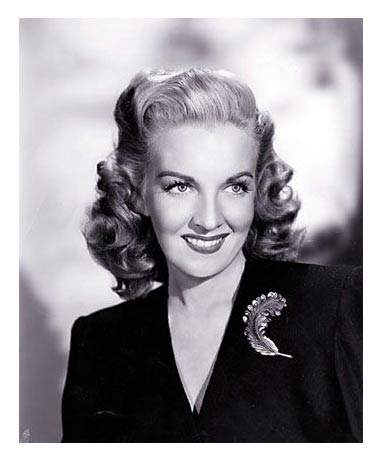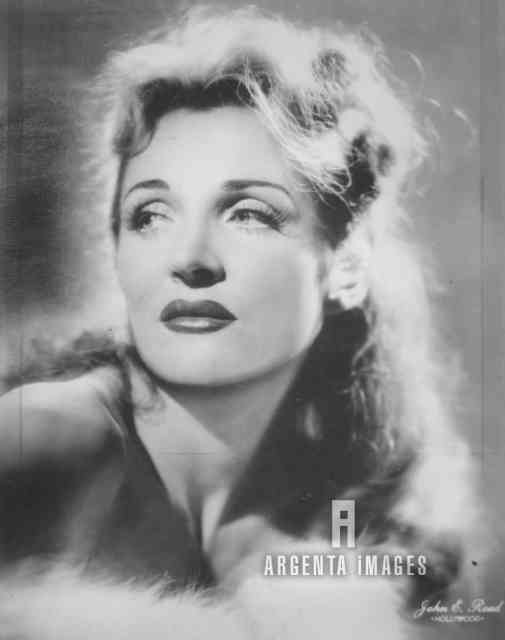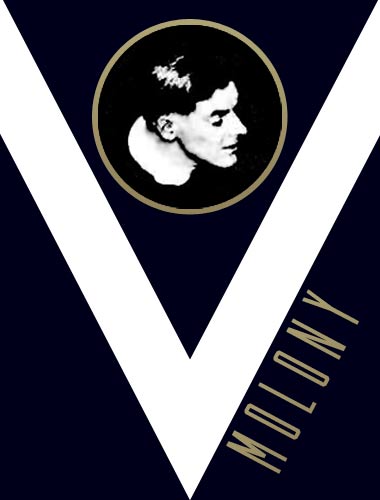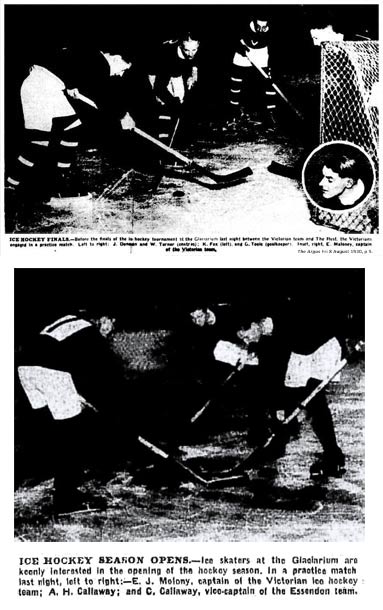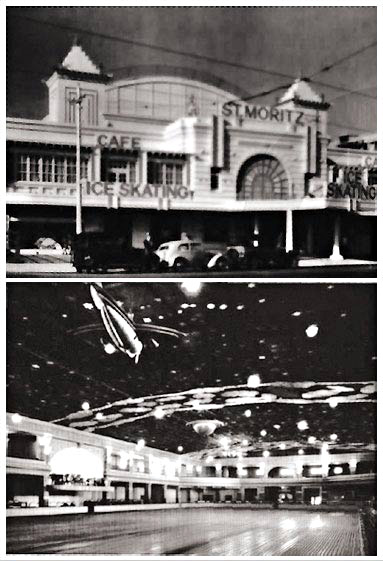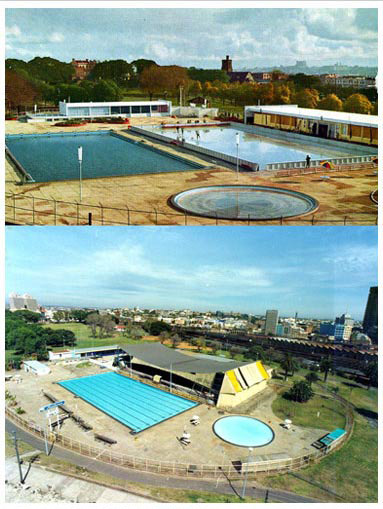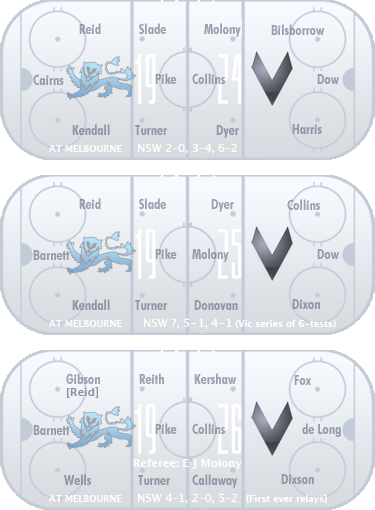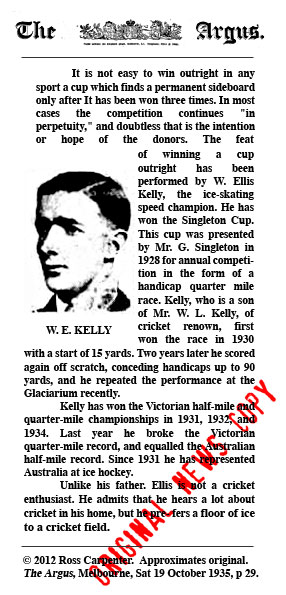Legends
home
1936 1st AUSTRALIAN Winter Olympian
1947 1st International Figure Skating GOLD Medallist
1960 1st Australian Olympic and World Championship ICE HOCKEY Teams Squaw Valley California USA
1961-2 2nd AUSTRALIAN Ice Hockey World Championship Ice Hockey Team Colorado USA
1963-4 2nd OLYMPIC Qualification ICE HOCKEY Team Tokyo Japan
1987 1st International Ice Hockey MEDAL Perth Australia
2008 Ice hockey World Championship PROMOTION TO DIVISION I Newcastle Australia
The First Ice Hockey Champions
Melbourne, 1960
 FTER THE 1960 WINTER OLYMPICS, in which Australia's only ever ice hockey team was soundly defeated, there was debate about the trade-off between selection standards and participation. Ken Kennedy was President of both the New South Wales and Australian Ice Hockey Federations at the time of the Games. At a 1963 meeting, he complained that the ice hockey team was not given trips because they were not world class, yet could never become competitive unless they had overseas matches. Edgar Tanner, a member of the Australian delegations to six Olympiads (1952-76), said "I ask the winter sports whether they really believe they are in world class, or world ranking, in the field of sport and whether they can do Australia credit, or just be there." Bill Young, manager of the cycling team, disagreed, saying "I thought the first spirit of the Games was to compete". [22] A quarter of a century earlier, Kennedy had left Australia at age 21 to train overseas, and that led to his selection as the sole member of the first Australian Winter Olympic team a few years later in 1936. He had also played for Birmingham Maple Leafs IHC during those years, at a time when the Club was part of the biggest amateur league in the world, and won the English League Championship. In fact, Britain captured the Triple Crown of World, Olympic and European ice hockey titles in 1936. Kennedy turned professional in England after the Olympics, and served in the RAF during the War.
FTER THE 1960 WINTER OLYMPICS, in which Australia's only ever ice hockey team was soundly defeated, there was debate about the trade-off between selection standards and participation. Ken Kennedy was President of both the New South Wales and Australian Ice Hockey Federations at the time of the Games. At a 1963 meeting, he complained that the ice hockey team was not given trips because they were not world class, yet could never become competitive unless they had overseas matches. Edgar Tanner, a member of the Australian delegations to six Olympiads (1952-76), said "I ask the winter sports whether they really believe they are in world class, or world ranking, in the field of sport and whether they can do Australia credit, or just be there." Bill Young, manager of the cycling team, disagreed, saying "I thought the first spirit of the Games was to compete". [22] A quarter of a century earlier, Kennedy had left Australia at age 21 to train overseas, and that led to his selection as the sole member of the first Australian Winter Olympic team a few years later in 1936. He had also played for Birmingham Maple Leafs IHC during those years, at a time when the Club was part of the biggest amateur league in the world, and won the English League Championship. In fact, Britain captured the Triple Crown of World, Olympic and European ice hockey titles in 1936. Kennedy turned professional in England after the Olympics, and served in the RAF during the War.
Harold Luxton died the year after the Melbourne games, and both Lewis Luxton and Kennedy died in 1985, two years before Australia won its first ever international ice hockey medal. But if you look very closely, they are there between the images in the viewer above. They are the players and officials of the 2008 Mighty Roos ice hockey team, who won gold on home soil at the world championships in Newcastle, NSW. All the team coaches and managers were born in Canada, along with four players. Two other players were born in the US, one in England, and one in the Czech Republic. But a majority of fifteen including the captain were born locally, and most had international hockey experience. They were promoted to Division I for the first time in history in the centenary year of Australian ice hockey. Australia has now competed with the elite Division I Group A ice hockey nations of the world. It is within one place in the World rankings of qualifying an Olympic ice hockey team once again (note 1 below).
Yet it was a very long line of Australian International champions who preceded them. In fact, there were over eighty in the first generation produced by Reid's rinks alone. Among them were Kennedy himself, the first Australian Winter Olympian, the 1st Australian Olympic and World Championship ice hockey teams, members of the Olympic Southern Flyers Ice Racing Club founded in 1949, speed skater Colin Hickey, and International ice show stars and skating champions such as Pat Gregory, Jack Lee, Reg Park, the Brown, Molony and Burley families, and expatriate skating pair, Enders and Cambridge. Many became local and International coaches and judges. They and their protégés placed Australia on the Winter sports map, with little or no public funds or assistance.
Notes:[1] Twelve teams qualify for the Winter Olympics Ice Hockey event, based on their IIHF World Ranking after the Men's World Ice Hockey Championships the prior year. The top nine receive automatic berths and the other three are determined using a qualification system for the 16 teams in the top Championship Division and the 12 teams in Division I. Mighty Roos were relegated from Division I to Division IIA in 2012, narrowly missing the opportunity for qualification for the 2014 Games at Sochi, Russia.
[2] Bill Young AM MBE, who thought "the first spirit of the Games was to compete," was one of two inaugural Life Members of the Australian Cycling Federation in 1979.
Ernest James KENDALL (Jim, Kenny)
(1889 - 1942)
JIM KENDALL WAS BORN ON FRIDAY 13th, IN DECEMBER 1889 at Sydney, Nova Scotia, the only son of Ida Burchell (1862 – 1909) and Lieutenant Colonel Dr Henry Ernest Kendall MD (1864 – 1949), who became Lieutenant Governor of Nova Scotia in 1942. [32, 59, 66, 68] His father, a physician, farmer and politician, was the younger son of London-born Emily Long (1823 – 1908) and Bristol-born Reverend Samuel Frederick Kendall (1818 – aft 1908). Samuel, a member of the Plymouth Brethren, helped establish the Union Church on Mitchell Island in 1866, on the north-west arm of Sydney Harbour. He attended meetings at the Baptist Church in Sydney, performed marriages and held bible study classes in a small meeting house which he built in front of his home at the corner of Charlotte and Pitt Streets. [73] His wife, Emily Long, was a supporter of Dr Barnardo, a social reformer who worked in the slums of London, and established orphanages throughout the United Kingdom. [73] Jim's uncle, Arthur Samuel Kendall (1861 – 1944), was a physician and politician like his brother; MLA, MP as well as Medical Health Officer for Cape Breton and a prominent social reformer. [63] This family emigrated from England to Sydney, NS in 1857, when it was a town of only 700 settlers drawn from all all over the UK and the neighbouring colonies. [73] In 1901, Jim lived at Sydney with his parents, younger sister Helen, and other relatives. The steel plant opened that year when he was 12, and it rapidly transformed Sydney into “the steel capital of Eastern Canada” for a century. [32]
Kendall became a steel manufacturer, [59] working at the Dominion Iron and Steel Co in Sydney, NS, during summer breaks, and perhaps also at the Nova Scotia Steel and Coal Co which was built nearby at the same time. Production was at its peak around the time he was old enough to work, and a 20-year long industrial unrest and stikes had begun around the time he left Canada. Some say he was from Halifax, the capital of Nova Scotia, about 300 km south-west of his hometown, but only his father moved there, and not until after Jim had left Canada. He first developed hockey skills in Sydney — in the amateur Maritime Hockey League (MHL) operating in Nova Scotia around 1900, and perhaps even its forerunners. Coincidentally, Bud McEachern played in the MSHL for Sydney Millionaires IHC, later in the 1940s. The MHL is notable for several Stanley Cup challengers including Sydney Millionaires. It evolved into the Maritime Professional Hockey League as part of the progression of elite amateur ice hockey leagues to paid professionals around 1910. [65] It was the first of the early recognized pro leagues formed from the Interprovincial Professional Hockey League 1910–11 season.
By 1908, the amateur and professional ice hockey teams of the Eastern Canadian Amateur Hockey Association (ECAHA) had separated, and the Inter-Provincial Amateur Hockey Union (IPAHU) became the premier amateur league in Canada. The Stanley Cup remained with the pro leagues and Sir Montagu Allan donated a new championship trophy for amateurs. The IPAHU's four-team league was Montréal's Victorias and Montréal AAA, Ottawa's Cliffsides and Toronto's AAC. It commenced in 1909 after Kendall had left Canada, and Montréal Victorias were given the Allan Cup to present to the champion of their league, who could then be challenged. Competition from the West didn't exist in these early days, although Winnipeg had formed an amateur hockey league in 1891. Senior amateur hockey in Canada at that time was more popular than the professional teams which only ever represented a handful of Canadian cities. Virtually every community of any size across Canada could and usually did ice a senior amateur team, and most consisted of "community players" born and raised where they played hockey.
Kendall was 19 years old when the amateur IPAHU was founded and it has been said he was offered a cadetship with the "Montréal Professional Club" in Montréal, Québec, the largest city in Canada at the time, nine hundred miles west of Sydney, NS. [2] The NHL was not formed until 1917, years after Kendall had left, but it had developed from many earlier professional leagues, including the short-lived Manitoba Professional Hockey League in which Montréal Wanderers played in 1906 and 1907, from home ice at Montréal Arena. They won eight Stanley Cup challenges 1906-10 to become one of the most successful pre-NHL clubs. Another, Montréal Hockey Club (aka Montréal AAA and Montréals), one of the four original IPAHU teams, competed in the purely amateur leagues until 1906, but turned professional for two seasons, then left the ECAHA for the amateur IPAHU. Their home ice was Victoria Skating Rink, Montréal, now officially regarded by the International Ice Hockey Federation as the birthplace of organised ice hockey. They won the first Stanley Cup in 1893, only to refuse it in a dispute with the MAAA, then again in 1894, 1902 and 1903. Montréal also iced the Canadiens, Nationals, All-Montréal HC and Shamrocks teams in various pro leagues from the 1909-10 season, but Kendall was already on his way to Australia via Liverpool, England. [80]
Jim's sister, Helen (1892– aft 1983) was born on November 29th, 1892 and she trained as a nurse with the Royal Victoria Hospital, near McGill University in Montréal with which it is affiliated. [68, 74, 80] She was old enough to attend from about 1907, traveled overseas during the war years, then worked in the hospital's operating theatre on her return. She later enlisted as a nursing sister in the Canadian Army Medical Corps on January 21st, 1917 when she was 24 years-old. [68] Her residence at that time was her father's address at 52 Morris Street in Halifax, Nova Scotia. Helen was an anesthetist in a war when, as she had said, "...the skills of doctors were too valuable to be tied-up administering anesthetics". These women served in hospitals in England, France and the Eastern Mediterranean at Gallipoli, Alexandria and Salonika and upon Hospital Ships. Helen was based in France across the Channel from England and at the 16th Canadian General Hospital at Orpington in Kent England (image right). [398] This hospital was one of the largest and most up-to-date military hospitals in the world in its heyday, treating more than 15,000 wounded soldiers between 1917–1919. Helen was awarded the Royal Red Cross (ARRC) for exceptional services in military nursing. This was one of 446 awarded to Canadian women who were fully trained nurses who had shown special devotion and competency in the performance of nursing duties over a continuous and long period, or who had performed some very exceptional act of bravery and devotion. Up to five percent of the total establishment of nurses could receive the ARRC. [68]
Many Montréal Wanderers had been members of the 1902 Montréal Hockey Club team, and it is quite conceivable that either club offered to take Kendall on as a rookie around this time. Instead, he left Canada for Australia, where amateur ice hockey had only just begun, and pro hockey did not exist at all. In 1910, Australian-born Tommy Dunderdale (1887–1960) joined Montréal Shamrocks at Victoria Skating Rink. It was sixteen years earlier in 1894 that Dunderdale had moved from Australia to Québec, and later Ottawa where he played in his Waller Street School team from 1904. Herbert Blatchly had also played ice hockey in Ontario leagues before he too immigrated to Australia and became captain of the first Australian ice hockey team in 1906 (see Tommy Dunderdale). In the early 1920s, Dunbar Poole, another player from that first Australian team, became a figure skating instructor at Minto Skating Club in Ottawa. Since 1904, this club had held National skating championships at the Rideau Skating Rink in which Dunderdale's school team played. In 1905, Dunderdale moved to Winnipeg, Manitoba and played the 1905–06 season with the amateur Winnipeg Ramblers. It was there that he first turned professional with Winnipeg Strathconas for three seasons, from 1906 to 1910, before moving to Montréal. Kendall had been offered a professional cadetship with a Montréal club a season or two before Tommy Dunderdale joined Montréal Shamrocks and, coincidentally, both were in the same places at about the same time as Blatchly, and later Poole.
Kendall may have planned to return to Canada, but it is also true that his family circumstances had changed dramatically. His grandmother, Emily, died in 1908 and his mother, Ida, died seven months later in 1909, when she was 49 years old. Jim was 19 and somewhere at sea between South Africa and Australia. [68] Both Emily and Ida had been active members of the Baptist church in Sydney, and both were well-known for their charitable acts. [73] His father Henry was approaching fifty, still a practising physician, but with farming and other interests. Henry was attracted to Margaret, who was half his own age and daughter of the wealthy industrialist and influential Canadian Senator John S McLennan. They married in 1913, at the McLennan's Petersfield estate, three years or so after Jim's mother had died and he had left the country. The Kendalls had been long-time family friends of the McLennans. Jim was very close to Margaret's brother Hugh McLennan (1887–1915), with whom he worked at the steel plant in the summers. [80] Similarly, Jim's sister, Helen, was a close friend of Margaret's sister, Katharine. They were the same age and they had played together since they were small and Helen spent most of her holidays from nursing school in Montréal with the McLennans. She often stayed at their Petersfield estate, across the harbour from the steelworks, especially after her mother died. She had acted as her father's hostess since then, and his marriage to Margaret was an upset. [80] Still, she remained Katharine's life long friend, a constant companion on Katherine's excursions, and on holidays at her summer homes in Ben Eoin and Ingonish. Neither married and, although they never lived together, they were quite inseparable. Helen was an immensely vibrant and energetic woman who led a comfortable but modest life-style compared to her father and friends. [74]
Jim's step-mother was just a few months older than Jim himself [68] — the sister of both his and Helen's best friends since childhood. While his father moved on to Halifax with his new bride, Jim's sister Helen and their uncle Arthur remained all their lives in Sydney. His father's branch of the family became part of the upper class with interests in collecting antiques and paintings, and in the lives and stately homes of their family in Canada, the US and England. Helen's friend, Katherine, served as a wartime nurse, but it appears that her work was done in the spirit of patriotic duty and paternalism, unlike Helen's commitment to nursing as a vocation, and certainly unlike Arthur Kendall's abiding and outspoken commitment to radical reform. Jim's step-brother, John, son of Henry and Margaret, felt a rift between the Henry and Arthur sides of the family, and it seems that their chosen careers made them socially distinct, and personally distant from each other. [73] Jim's father was a Mason, a member of the Independent Order of Oddfellows and of the Sydney Club, a private professional men's club of which he was President for at least one term. He berthed his cutter at the Royal Cape Breton Yacht Club, and served as its Vice-Commodore in 1901.
On the other hand, his uncle Arthur was a part of a professional middle class in Sydney and, although he too was a member of the Sydney Club, he was not a member of the wealthy and elite, which included many of the investors in the Dominion Iron and Steel Company, such as J S MacLellan and his associate A J Moxham, its American-born, first general manager. Arthur had married Mary, a daughter of the well-established Crawley family of Sydney. Her great-grandfather was Captain Thomas Crawley, a former Surveyor-General of Cape Breton Island, and her father was Baptist minister Rev Arthur Crawley. She was active in the church with Jim's mother and grandmother until their deaths. Around the time Jim set out for Australia, his uncle was MLA for Cape Breton, with a seat in the House of Assembly at Halifax. Arthur's different social interests were well-publicised and included fighting poverty caused by the rapid industrialisation of Cape Breton, improving living conditions, and lobbying for old-age pensions, a shorter work week and a workmen's compensation act. He acted as a conduit between the working class and the owners of the steel plant and coal mines. [73] The steel industry in Cape Breton, as elsewhere, was extremely dangerous. In the mid-1980s, a monument was erected in front of the union hall in Sydney listing the names of 304 individuals who had lost their lives at the steel plant.
The McLennans had a long history of involvement with Montréal and McGill University, where the world's first organized hockey club, made up of McGill students, played their first game in 1877. The Society for International Hockey Research (SIHR) now note the significance of the game played by James Creighton and several McGill University students at Montreal’s Victoria Skating Rink on March 3rd, 1875. This is the earliest eyewitness account known to the SIHR of a specific game of hockey in a specific place at a specific time, and with a recorded score, between two identified teams. The McLennans had given McGill financial aid since 1881; family members held honourary librarian and governor positions there; and they financed the University's McLennan Traveling Library in 1901, which still operates today. [74] McGill University library is named after Isabella McLennan, eldest sister of Kendall's step-mother, whose bequest largely financed it. Jim's friend Hugh McLennan studied Arts at McGill University between 1905-7, when he was 18 to 20 years old. He then left for Paris to study architecture at l'Ecole des Beaux Arts. He enlisted in the Canadian Field Artillery in 1914 and was killed in action at Ypres, Belgium in 1915. [83, 84] Kendall was almost three years younger than McLennan. He had probably also studied further after high school, and quite possibly at McGill, from about 1907. A friend of Kendall's sister said in Sydney, NS in 1996: " ... [Jim Kendall] and Katharine McLennan's brother Hugh were very close friends and they had, as young men, worked over at the steel plant in summers, and then Hugh was killed. Anyway, Jim – James Kendall – decided he'd see the world so he took a tramp steamer. He found himself in Cape Town and he didn't have any money and he wore his pajamas on the boat. That was his garment on the boat because he was saving his suit for the land. Anyway, he put on the suit and hitched a ride, he wanted to see the diamond fields in South Africa because the tramp steamer was going to be in for a few days, so he had a two or three days off. So he got on this train, and this was quite an offense in South Africa, and he got put in jail and he was desperate ... but he got out and on to the boat and went to Australia." [80]
The tramp steamer was the White Star Line SS Runic which originally ran a regular service between Liverpool and Australia via Capetown. However, the Huddardt Parker & Co Line had been absorbed by White Star and others a year or two earlier. Huddardt ran the first service from Vancouver to Sydney, and so Kendall, then a 19 year-old salesman, had probably boarded at Vancouver. He arrived in Sydney via Melbourne on June 26th, 1909, to be greeted by the painful news of his mother's death, two weeks earlier on the 9th. [80] This was the year the Goodall Cup was first contested although, according to the official record, Kendall did not play until two seasons later. [1,2] He was a little over 5-foot 11-inches tall (181 cm), with a 41-inch chest (104 cm), and weighed in at 12 stone 4 lbs (78 kg). He had a dark complexion, brown eyes and hair. [59] He regularly commuted 160 km between Newcastle and Sydney to start game play at 10.15 pm, then returned on the 'Paper Train', as it was commonly known. He played his first game for NSW in 1911 at the age of 22 and he also played on the 1912 and 1913 NSW teams. [1]
Ice hockey in Australia by this time was conducted according to McGill Rules (1879) introduced in Melbourne by 1908, and although Victoria assigned two rovers to tag Kendall, it made little difference. [2] The Cup left Victoria for the first time that year, remaining in NSW for two years, and Kendall was instantly regarded as the best ice hockey player in Australia for years thereafter. The Victorian Interstate Hockey Programme in Melbourne in 1932 reported concern among the Victorians from the time of the first NSW practice session: "Jim Kendall caused consternation and amazement with the Victorian players and selectors by his amazing speed, accuracy and powerful shooting and was virtually a match on his own for the Victorian team." [2] The Sydney Ice Hockey Club had established three local teams in 1911; Ottawa, Corinthians and Wanderers. [2] The name Corinthians, Kendall's team, comes from a little city called Corinth in Greece, known for its wealth and decadence. It means a rich amateur sportsman, especially an amateur yachtsman. Wanderers, was led by State captain Jack Pike, but may have been named after Montréal Wanderers, one of the two Canadian professional teams with whom Kendall is likely to have had some affinity. Yet, it was most likely named after a Western Sydney soccer club called the Wanderers, one of the first registered clubs to play a soccer game in Australia against the King's School's rugby team in 1880. Dunbar Poole was associated with soccer in New South Wales and he played in the 1911 Goodall Cup. Over a century later, a new A-league soccer club was formed in Sydney in 2012, and named in homage to the original Wanderers.
Some say Jim Kendall was Australia's first Canadian ice hockey player but, in fact, he was the second. The first on record was Toronto's Herbert Blatchly (abt 1872 – 1948), captain of the 1st Australian Team in 1906. Nonetheless, skills like Kendall possessed had probably not been seen in Australia up until then. He revolutionised NSW ice hockey through his Canadian training and ability, but Victoria still took the interstate honours 2-1 in 1913, winning the Cup back, even with Kendall opposing them. The Victorian Association lost Brighton IHC in 1912, reduced to just three teams, but it was restored to full strength in 1913 when Brighton IHC was reconstituted. The 1914 season was abandoned immediately war broke and ice hockey in Australia did not resume until 1919 in Melbourne and 1920 in Sydney. [1]
In 1914, Kendall lived at 45 Phillip Street, Sydney, NSW, a short distance from Circular Quay. [91] The terrace building is now heritage protected and presently occupied by Phillips Heritage Restaurant. Kendall had spent two months in the New South Wales Lancers, and then enlisted in the Australian Naval and Military Expeditionary Force. He did that on August 11th, 1914; the day after volunteers were called; the day after his friend Hugh McLennan enlisted in the Canadian Field Artillery. Kendall was 24 years old when he became a soldier in the first infantry to leave the country, while the Australian Imperial Force (AIF) was still being formed. He sailed on P & O Liner Berrima to capture Rabual in German Papua New Guinea, and served there as a Private in the Tropical Unit of B Company, seizing and destroying German wireless stations. [69] There were 117 men in this unit and among them was another young Canadian, Jimmy Bendrodt, who had enlisted the same day as Kendall. He was a roller skater from Victoria, British Columbia who, after attending school in Vancouver, worked his passage to Sydney as a stoker, arriving with only five pound the year after Kendall. Dark, lithe and muscular, he claimed to have been a lumberjack and to hold Canadian roller-skating titles. Appointed manager of the new Imperial Roller Rink, Hyde Park, he soon secured the lease and fostered an exclusive and decorous image that was to characterize all his enterprises. He reopened the building as the 'Imperial Salon De Luxe' early in 1914, a few months before he enlisted, to cater for American dance crazes. [94] A roller rink named Salon de Luxe was established at South Yarra in Melbourne in 1914 (see Robert Jackson).
Bendrodt was a racehorse owner-breeder from sometime in the early 1920s, and later owner-operator of the Ice Skating Palais; Sydney's second ice rink. Both these business interests figured in Kendall's future, and it was in the Tropical Unit of this special military force that the pair formed their first association; in 1914 and perhaps earlier. They returned on HMAT Eastern on January 9th, 1915 in charge of prisoners of war, and they were discharged about one week later when the Force's six month period of special service had expired. [59] Neither saw action. Within a few months Kendall received news of the death of his friend, Hugh McLennan, who had been killed in action on the Western Front in late-April. In Sydney the same year, he married Hilda Mary Dibbs (1894 – 1978), daughter of Charles H J Dibbs and Matilda Harris of St Leonards, NSW. [33] Hilda has been described as "a Baroness or something or other, a great socialite in Sydney, Australia". [80] They spent part of the remainder of the war in Canada, probably with Helen and uncle Arthur, and the grieving McLennans. Jim's father enlisted in the Canadian Overseas Expeditionary Force in June 1916. [71] He was Lieutenant Colonel of the 9th Stationary Hospital based at Bramshott Military Hospital, England, for three years between September 1916 and 1919. Bendrodt also returned to Canada and served in the Canadian Expeditionary force in 1918, but he was back in Australia by 1919. The Kendalls had returned by June 1916 and resided at the Criterion Hotel in Newcastle, New South Wales, near the Newcastle GPO. [186] Their son William Ernest Kendall (1916 – 2004) was born there in June 1916. In all probability, it was Kendall who introduced Bendrodt to Australian ice hockey. And it was Kendall who was first to succeed with horse racing.
In 1915, Broken Hill Proprietary Company (BHP, now BHP Billiton) opened its steelworks at Newcastle, NSW, which had a very similar industrial climate to Sydney in Nova Scotia. It dominated the industry nationally for 84 years, employing about 50,000 people by the time it closed in 1993. Kendall was appointed BHP's Chief Mechanical Engineer after he returned from Canada during the war, sometime before 1917. His future business partner, BHP metallurgist Leslie Bradford (1878–1943), was transferred to their Newcastle steelworks the year it opened. Bradford had invented an improved process for treating ores, and he had also perfected the flotation process of separating silver-lead and zinc about 1912. One historian claims it "constitutes perhaps the greatest single metallurgical improvement in the modern era". Also among Kendall's friends was W Nicholson, the owner of racehorse Jack Findlay, ridden by the most acclaimed jockey of the time, W H "Midge" McLachlan. Kendall, Bradford, and a group of friends, punted on the horse, rolling-over their bets on five straight wins between 1919 and 1920. By January 24th, 1920, they had won a small fortune of 15,000 pounds. Kendall and Bradford both resigned from BHP and used their winnings to establish Alloy Steel Syndicate on April 28th, 1920, and a steel foundry in Alexandria, Sydney. Bradford Kendall Ltd was registered as a public company in 1922 with Jim Kendall as Managing Director. BHP attracted Bradford back soon after, and he became their production superintendent, manager of the steelworks in 1924, general manager in Melbourne under Essington Lewis in 1935, and CEO of BHP in 1938. [78] However, Bradford still remained an active director of Bradford Kendall Pty Ltd, by then a major foundry, and he also established Bradford Insulation Ltd in 1940 to manufacture rock-wool from steelworks' slag. [79] Today, BHP Billiton is the world's largest mining company, and its huge expansion around the time Kendall and Bradford departed was jointly financed by the Commonwealth Bank, John Goodall & Co of Melbourne, and a Sydney sharebroker (see John Goodall).
Kendall's company originally made contract castings for general industry, then licensed products in the form of railway couplers and under-carriages in 1926. It excelled in the Great Depression by supplying manganese steel products to the mining industry, and later by manufacturing dredge buckets for the Malayan tin mining industry. It's main railway supply business suffered after the Depression and production changed to armament castings during World War II. It built a foundry for the Commonwealth Government to make cast armour for the Australian-built tank program, starting with aerial bombs, naval gun parts and tank hulls. Then came their design for the world's first one-piece cast tank hull in 1940. It was accepted by the Ministry of Munitions and Bradford Kendall were commissioned to make the Cruiser tank. With Kendall's son at the helm after the war, growth was further boosted through renewal of Australia's neglected railway systems. In 1948, the company listed on the Sydney Stock Exchange, growth surged on into the 1950s, and Bradford Kendall foundries were built in South Australia, Western Australia, Victoria and Queensland. Today, the company is Bradken; Australia's largest combined foundry and heavy engineering group and one of the leading ferrous-casting companies in the world. From its corporate office in Newcastle, it operates 18 specialised manufacturing facilities and five businesses throughout Australia, New Zealand and the United Kingdom with a 2,800-strong workforce. [78]
Kendall resumed his hockey career when Sydney Glaciarium re-opened in 1920. It has been said his coaching gave New South Wales a distinct advantage over Victoria, but American hockey star, Charles Uksila, was also a trainer in Sydney this year (see Charles Uksiila). Kendall was a founder and captain of the NSW Eastern Suburbs Ice Hockey Club and coached players such as Jim Brown and Ken Kennedy. These were still early days for Australian ice hockey — the Sydney Glaciarium IHC at the time was comprised of only 35 members. It was renamed Sydney IHC on June 22nd, 1921, operating as the forerunner to the NSW State controlling body. Kendall's club and three others were formed at the same time and team strength went from six to seven players. Seven was consistent with the original Canadian team strength, which didn't reduce to six until 1913 in Nova Scotia, and 1923 on the west coast when the Rover position was dropped. Six men a side was re-introduced to Australia in 1922, and introduced at the Olympic Games in 1924. [2] One of the other new teams was captained by Jack Pike, and another by Leslie Reid (1894–1932), son of Henry Newman Reid. Leslie was Vice President of the first Sydney Glaciarium Ice Hockey Club by 1920 when Pike was president, and it has been said that his hockey skills rivalled those of Kendall. [2] Kendall was not among the local and State team selectors of this era. Leslie Reid, Norm Joseph and Jack Pike were elected by the club in July 1920, May 1921 and again in March 1922. [2] The four new clubs formed on June 22nd, 1921 were:
Eastern Suburbs IHC (7) — Jim Kendall (c), Frank Joseph, W Panter, F Whyte, H Tanner, S Schute, John Lovelace.
South Sydney IHC (6) — T Gibson (c), H Butler, C Fowler, E Hewitt, Dr Murphy, W Power.
Western Suburbs IHC (9) — Jack Pike (c), Carl Kerr, John Kerr, Dr Hamilton, W Store, T Wells, W Webb, J Carpenter, John Lowick.
North Shore IHC (10) — Leslie Reid (c), C Gates, Norm Joseph, H Ives, W Watkins, Reginald Boyden, Henry Hinder, D Cathro, L Cathro, S Green. [2]
The clubs were also referred to as Easts, Souths, Norths and Wests. Interstate games resumed the next year and New South Wales won the Goodall Cup. Victoria won it back the year after in 1922, then New South Wales dominated, perhaps winning fifteen of the seventeen contests between 1923 and 1946. Victoria tied the 1932 and 1946 series but New South Wales kept custody of the Goodall Cup (see Ted Molony). In 1926, The Argus newspaper in Melbourne reported, "A notable absence from the New South Wales team is J Kendall, who has retired from the game. With the exception of Kenny, the personnel of the New South Wales team is the same as last year, when NSW easily defeated Victoria". [133] Kendall was 37-years-old, but he continued to coach. In 1937, at the age of 48, he returned to coach the new Sydney University Ice Hockey team in the reserve grade showing "that he has lost none of his skill in handling the puck". [541] This club had been formed with members of the four senior clubs who attended the University. The state association hoped it would develop into a fifth senior club and, although it performed credibly, it disbanded in 1938. [1]
In 1924, the season before he retired, Kendall's Eastern Suburbs again won the New South Wales ice hockey premiership and the Hamilton Trophy. Kendall won the Tintex Cup for the highest scorer with 18 goals, half the total his team scored that season. The manager of the Studebaker factory in Detroit and Cleveland visited here that year and said Kendall was "the equal of any of the American or Canadian players." [566] Jim Kendall was elected the first life member of the NSW Association although he is no longer listed by the New South Wales association. There were a total of four other life members when Jim Barnett, the former State and Glebe goalkeeper, was elected a life member in 1937: E. J. Kendall, D. Poole, N. P. Joseph and C. V. Kerr. Like Kendall, Jim Barnett is no longer listed. [567]
Jim Kendall contributed many years to the sport as a player, coach and administrator from within a few years of its inception in Australia. He was also an accomplished yachtsman and competed regularly in 13 ft and 16 ft skiff racing on Sydney Harbour, and in larger yachts farther abroad. He sailed his skiffs "Iris", "Cibou" and "Oweenee" from the Drummoyne and Port Jackson 16-ft Skiff clubs. He was 1924/25 State champion in Iris on Lake Macquarie, and the E J Kendall Cup at Port Jackson club was named after him early 1930s. These skiffs are unique in the world and peculiar to Australia.
Kendall's son William Ernest 'Bill' Kendall, was a Harvard graduate and represented Australia in 100 metres freestyle swimming at the 1936 Berlin Olympic Games attended by his parents, finishing 5th in the semi-finals with a time of 59.9 seconds and 12th overall. He married Australian figure skating champion Betty Maxwell at Woollahra where his parents lived in 1942, and had two children, James and Brooke. [33]
Jim Kendall was living at Oak Lodge Trelawney Street Woollahra when he died at age 53 on May 5th 1942, [21, 542] the year his son married; the year his 78-year-old father became Lieutenant Governor of Nova Scotia, and moved into Government House, the oldest vice-regal residence in North America. His father retired after 5 years as Lieutenant Governor to his home in Windsor where he died two year later. After Jim's death, his son Bill was appointed Managing Director of Bradford Kendall Ltd and he retired in 1979 after 36 years. Jim's wife Hilda remarried in 1953 to Baron von Nordegg-Rabenau of Austria who had moved to Sydney. The couple were Sydney socialites, oftened photographed at parties, departing overseas, with interior designers, or at art shows. The baron was an Olympic attaché for the 1956 Games in Melbourne. Kendall's sister, Helen, visited Australia twice late in life with her friend, Katherine McLennan, and eventually became a beneficiary of her brother's estate after the death of his wife in 1978 in Sydney. [80] To perpetuate Jim's memory, the 'Jim Kendall Trophy' was presented in 1949 by former NSW Association President, Harold Waddell Hoban and Ken Kennedy's father, Jack. It was awarded to winners of the inter-rink matches between Sydney's Glaciarium and Ice Palais teams.
![]() Eastern Nova Scotia - Prince Edward Island | Map | Sydney - Montréal | Map |
Eastern Nova Scotia - Prince Edward Island | Map | Sydney - Montréal | Map |
Sydney Steelworkers | Undated | COM Henry + Ida | 1888 | Ida - COD | 1909 | S S Runic Ship's List | 1909 |
Jim - Enlistment | 1914 | Hugh McLennan | 1914 | Petersfield | various | Helen at war | c 1918 |
Sydney, NS | 1920 | Horse Race | 1920 | Annual Meeting | 1926 | Cruiser Tank | 1940 | Henry - COD | 1949 |
Historical notes:
[1] Henry Kendall was Lieutenant Governor of the Province of Nova Scotia between November 17th, 1942 and August 12th, 1947; long after his son had left Canada. In fact, Jim died the year of the appointment, so he may not have even heard. Henry was age 78 when sworn in, the oldest to hold this office in the history of Nova Scotia, and one of the oldest in all of Canada. Lieutenant Governors are Royal representatives appointed by the Governor General on the recommendation of the Prime Minister of Canada and the Federal Cabinet. He lived in Government House at Halifax, the oldest vice-regal residence in North America, for almost five years. His political career had commenced at least twenty years earlier, when on June 12th, 1921, he was an unsuccessful Progressive Party candidate for the Federal Riding of Hants, Nova Scotia, in the 14th Parliament. [67] He was succeeded as Lieutenant Governor by John Alexander Douglas McCurdy (1886-1961), the first person to fly an airplane in Canada and a founder of the Royal Canadian Air Force. Henry Kendall died two years later at the age of 85 in Windsor, NS. He was interred with his first wife Ida, brother Arthur, and mother Emily at Hardwood Hill Cemetery, Sydney, NS. [68]
[2] Jim Kendall's uncle, Arthur Samuel Kendall (March 25, 1861 – July 18, 1944), was a physician and political figure in Nova Scotia like his brother. He was a Liberal member representing Cape Breton in the Canadian House of Commons from 1900 to 1904. He graduated from Mount Allison College in 1879, Halifax Medical College in 1881, and Bellevue Hospital Medical School in New York in 1882. He was certified as a Member of the Royal College of Surgeons from Guy's Hospital Medical School in London, England in 1884 and returned to Sydney to establish a medical practice later that year. [73] His younger brother Henry, Jim Kendall's father, was also a practising physician and may have attended some of the same schools. But it was Arthur's time in England that enabled him to see in advance the effects of industrialisation, which in turn shaped his reformist agenda. Arthur served as a town councillor for Sydney in 1888 and ran unsuccessfully for a seat in the House of Commons in 1896. He represented Cape Breton County in the Nova Scotia House of Assembly (MLA) from 1897 to 1900 and from 1904 to 1911. [63] Arthur's association with Cape Breton coal miners built his reputation as the "miners friend'' and someone "for whom the miners had great affection". He did not appear to care unduly about personal wealth or physical appearance. The County of Cape Breton 1979 Centennial Booklet contains a photograph of an elderly Arthur Kendall, unassuming and kindly, wearing a cloth cap and a tattered fur coat that is strapped around his chest and waist, with two stout leather belts — displaying an obvious "unconcern for his sartorial condition." [77]
[3] Simon Fraser (1832–1919), grandfather of former Prime Minister Malcolm Fraser, was born in Pictou, Nova Scotia (map at link above). He grew up there and immigrated to Australia in 1854 at the age of 22, where he bought extensive estates in the Western District of Victoria. There he became a leader of the wealthy wool-growing class known as the squatters, which included the Armytage family. Fraser was elected to the Victorian Legislative Assembly for the seat of Rodney in 1876 where he served until 1883. He was elected to the Victorian Legislative Council, the traditional preserve of the squatters, for South Yarra Province in 1886, and remained a member until 1901. He was a Minister without Portfolio from 1890 to 1892. He was a Victorian delegate to the Imperial Conference in Ottawa, Canada in 1894. Robert Reid, uncle of Henry Newman Reid, was also in Ottawa in May 1894. Reid had arrived the year before, the year Lord Stanley donated the Stanley Cup (see Henry Newman Reid). Fraser was a member of the Constitutional Convention which drafted the Australian Constitution and he was closely related to the family of John Goodall.
[4] Known links between members of the NSW Ice Hockey Association and NSW horse racing at this time include Kendall and W Nicholson; Jimmy Bendrodt (1891–1973), racehorse owner and manager of the Sydney Ice Palais. In 1920, Bendrodt may have been patron of Glaciarium Ice Hockey Club in 1920, the earliest forerunner of the NSW Association. Kendall resumed playing that year and he is on record in 1923 as attending the Association meetings. [2] Bendrodt may have been part of Kendall's racing circle. Bill "Midge" McLachlan (1889 – 1967), who rode Jack Findlay in 1920 and catapulted Kendall and Bradken to success, was great-grandfather of the Freedman brothers. Midge was one of the most acclaimed jockeys of his time. His feature wins included three Melbourne Cups, two Caulfield Cups and two Sydney Cups, and he is widely (though wrongly) celebrated as the first Australian jockey to ride for the royal family in England. In fact, that distinction belongs to his son, William Henry McLachlan (1908 – 1964) or "Young Bill," who died at Randwick in 1964.
[5] NHL Correspondent, Bill Meltzer, writing in April 2008 for the IIHF, claimed Kendall was a 'one-time Montréal Canadiens player'. The Canadiens were founded by J. Ambrose O'Brien on December 4th, 1909, as a charter member of the National Hockey Association, the forerunner to the National Hockey League. Kendall arrived in Australia from Liverpool England in June 1909. He had left Canada at least a year before the club was founded. Meltzer also wrote that Kendall played in the first Goodall Cup in 1909, but he first played in 1911. [1, 2]
[6] In June 2002, the Society for International Hockey Research (SIHR) released an 18-page report concluding that the first ice hockey match was played at the Victoria Skating Rink in downtown Montreal on March 3rd, 1875. The next month, the International Ice Hockey Federation (IIHF) picked Montreal as the birthplace of ice hockey over other Canadian communities — including Kingston, Ontario and the spot near Windsor, NS where many Nova Scotians feel the first game was played. According to both the IIHF and the SIHR, although sports that resembled hockey may have been played in other places before 1875, the first actual game with a puck, nets and a specific set of rules was in Montreal (see Montreal Hockey History at Hockey Heritage).
HENRY CRITCHLEY HINDER (1899 – ) "H Hinder", founding member North Shore IHC, NSW, 1920. Born in 1899 at Summer Hill, Ashfield, NSW, eldest son of Henry V Critchley Hinder (1865–1913) and Ethel Enid Pockley of St Leonards, NSW. Summer Hill is 8 km west of the Sydney CBD. Brother of Francis (Frank) Henry Critchley Hinder (1906–1992), an award-winning Australian painter, sculptor and art teacher who is also known for his camouflage designs in World War II. Like Frank, Henry probably attended his father's alma mater, Newington College, and on moving to the North Shore completed his education at Sydney Church of England Grammar School (SCEG aka Shore School). Frank's biography and work can be viewed at Art Nomad and the Official Website of his estate. [256]
SCEG was founded on May 4th, 1889, an initiative of Bishop Dr Alfred Barry of the Sydney Diocese of the Church of England. The foundation headmaster was Ernest Iliff Robson BA MA (1861–1946). Five years prior in 1884, Robson had been recruited by John MacFarland as inaugural classics teacher for Ormond College, University of Melbourne. He was succeeded by Barney Allen, its vice-master, and in 1895 married Kate Isabel, daughter of Alexander Morrison, headmaster of Melbourne's Scotch College. Ormond and Scotch colleges were closely associated, and Robson no doubt had a hand in the design of the SCEG badge which contains symbols from both schools, notably the four brightest stars of the Southern Cross on an Oxford blue background, first used by Scotch College (see John Grice). This was quite unlike the earlier crests of Sydney Grammar and the University of Sydney which both use the representation of the Cross that appears on the New South Wales State badge. It was a compromise, sitting somewhere between. Robson returned to Melbourne and was appointed classics master at Melbourne Church of England Grammar School in 1901 and acting head in 1905. Next year he became vice-warden and classics tutor at Trinity College, University of Melbourne.
JOHN WARNE LOWICK (1892 – 1969) "J Lowick", founding member Western Suburbs IHC, NSW, 1920. Born April 29th, 1892 at Mosman, NSW, only son of Robert Warne Lowick and Annie Armitage of Sydney. His older sister, Jessie, was born in 1888. Lowick was a 22 year-old, unmarried clerk living with his family at Wakefield Street, North Manly, NSW, when he enlisted on February 8th, 1915, as a bugler in 13th Battalion, 4th Reinforcement, AIF. He served overseas embarking Sydney on board HMAT A9 Shropshire on March 17th 1915. He was a veteran of Gallipoli with the 13th Battalion, where Leo Molloy also fought; then Egypt with 45th Battalion from March 1916, and France from June 1916. His battalion was heavily engaged during the battle of Messines in June, and suffered commensurate casualties. AIF operations switched to the Ypres sector in Belgium and the 45th took part in another major battle near Passchendaele on October 12. Conditions were horrendous; the operation was hastily planned; and thus resulted in failure. Awarded the Military Medal in 1917, "...for his courage at Zonnebeke on 12th October 1917. He went on several occasions and repaired broken wires during a severe enemy barrage and counter attack. His coolness and determination was most marked and his perserverance in his duty enabled communication to be maintained at a critical time. Recommended by Major Stanley Llewellyn Perry MC." Promoted 2nd Lieutenant and Lieutenant in 1918. Moved to Kempsey, NSW and served as Lieutenant 30th Battalion in 1944-5, during World War 2. John Lowick was wed in Sydney in 1927 to Ellen Margaret Grant, daughter of Thomas and Ellen Grant. His wife Ellen died in 1942 at Randwick, and he died in 1969 at Burwood in Sydney. [255]
JOHN ALFRED LOVELACE (1885 – 1969) Probably "J Lovelace", founding member Eastern Suburbs IHC, NSW, 1920. Born in 1885 at Paddington, NSW, eldest son of John Alfred Lovelace and Annie Elizabeth Reece of Sydney. [254]
REGINALD HASLAM BOYDEN (1896 – 1937) "R Boyden", founding member North Shore IHC, captained by Leslie Reid. Born on August 21st, 1896 at Surrey Hills in Victoria, the third son of accountant Frank Ernest Boyden (1858–1930) and Annie "Daisey" George (1864–1943). His brothers were Frank Arthur Stewart (1890–1952); Nicholas Lancelot "Lance" (1893–1972); Paul (abt 1900–1955); Arthur Keeling (1904–1976); and sister Lily, all born in Melbourne. His family moved to 21 Harbor Street in Mosman, on Sydney's Lower North Shore, where the Reids lived from 1917. His father was a senior member of the firm of Boyden Sons & Co, public accountants, and chairman of directors of Rapid Electrical & General Heaters Ltd, established in Sydney in 1921. This company had patented the Rapid Electric Jug and successfully contested a patent infringement in the High Court in 1931, the year after Boyden's father died. [257]
Reginald was a clerk who probably worked in the family accounting practice. He was 5-foot 4-inches tall, 119 pounds in weight, with a 33-inch chest, blue eyes, and fair complexion. He enlisted at the age of 18 on January 7th, 1915 at Liverpool, Sydney and served as a Corporal in B Company, 18 Battalion, AIF. His eldest brother, Stewart, lived with his wife at Darnum near Warragul in West Gippsland, Victoria. He followed his brother and became Major of C Company, 19th Battalion. Reg was shot in the chest by a rifle bullet after two months in action at Gallipoli. Invalided, he returned to Australia after eight months service. Next eldest, Lance, enlisted in November 1916 and became a Lance Corporal in the 4th Battalion in which Leo Molloy was Quartermaster. All three had retured home safely by the end of the war.
The letters of Boyden's mother to his youngest brother Arthur during the Second World War feature in an Australians at War story about a mother who continued to write to her son, not knowing whether he was dead or alive. Arthur had been captured by the Japanese and held as a prisoner of war. He returned from war to find his mother's death had been hastened by grief over two years earlier. Four of five sons had seen action in world wars. [257] Despite the existence of a World War 2 record in his name, Reginald Haslem Boyden died at age 40 on February 19th 1937. The Airlines of Australia Stinson he piloted crashed on the Lamington Park Plateau, near the Queensland - New South Wales border, killing him and 4 others. [418] It was the air crash that made Bernard O'Reilly a hero. O'Reilly's book about the rescue was made into the 1987 TV movie Riddle of the Stinson starring Jack Thompson.
Photographer John Lindt (1845–1926) had a studio in Collins Street, Melbourne and his society, theatre and landscape photographs were highly reputed. He even photographed the capture of the Kelly gang at Glenrowan in Victoria in 1880. Late in the 1880s, he photographed the Chaffey brothers' irrigation works on the Murray River and, on January 8th 1890, he registered copyright of the work in England, with Boyden's father and William Herbert Jones as joint owners (copies held by NLA). A chemist named William Herbert Jones was born in 1887 and his parents lived at 20 Norris Street, Surrey Hills, where the Boydens lived prior to Sydney. Chemistry was central to agricultural science and Jones' father was possibly also a chemist and third owner of the copyright with Lindt and Boyden. [257]
Before they went to Australia, the Canadian-born Chaffey brothers had moved to Kingston on Lake Ontario in 1859. In 1878, they moved again with their father to Riverside, near Los Angeles, California, where they developed an irrigation settlement. Northern Victoria suffered from drought between 1877-84, and Alfred Deakin (1856–1919) visited the California irrigation areas in 1885, with politician John Lamont Dow (1837–1923) and his brother. There they met the Chaffey brothers and this led to the irrigation works on the defunct Victorian pastoral lease, Mildura. Deakin was then a minister in the Service-Berry government and chairman of a royal commission on water supply. John Goodall's family were very influential in California at this time (see Goodall), and Sir Simon Fraser had helped to arrange the Service-Berry coalition, then toured Europe and America in 1883, two years before Deakin. On his return, he undertook pioneering work in artesian water supply with Canadian J S Loughead in 1886, the same year the Chaffeys commenced their Mildura irrigation works (see Fraserland). The Dow brothers were agricultural journalists for The Age and Argus newspaper groups, and behind them lay powerful mercantile and political groups which promoted farming, rather than grazing.
Newsagent Andrew Lambert Reid (1866-1889), brother of Henry Newman Reid after whom Andy Reid was named, began Mildura's first circulating library. Their father, John Lambert Reid, was Trustee of the Public Library (now State of Library Victoria). Andrew Reid Sr died at Mildura when he was just 23 years-old, and was buried on the site of the original Mildura pastoral lease and station. This was where the Chaffey vision for the irrigation colony evolved (see The Chaffey Trail), and Reid had been present when it began in 1886, until his early death there three years later. The Chaffey's work was essential for the emergence of the dried fruit industry in Victoria and South Australia, and provides an enduring legacy in irrigation. Soon after, Reid's uncle Robert, Minister for Defence in the Patterson government, toured Britain and North America on a diplomatic mission to foster closer trade relations. He visited New York, Vancouver, Montréal, Ottawa and Toronto, and met with the successor to Governor-General Lord Stanley, the year the Stanley Cup was first presented. Sir Simon Fraser joined him in Ottawa that year (see Fraserland).
![]() Arthur Boyden | 1919 |
Arthur Boyden | 1919 |
Thomas DUNDERDALE
(1887 - 1960)
BORN ON MAY 6TH, 1887 AT Benalla, an agricultural town in north-eastern Victoria, Australia, to English-born parents, Thomas Dunderdale (1858– ) and Elizabeth Day (1861– ). His older English-born brother was named Henry and his younger sisters, both born in Australia, were Daisy, and Nellie who married Harley Gould. [270] Tommy Dunderdale is the only Australian-born player inducted to the Hockey Hall of Fame, so why has he been overlooked by Australian hockey? Perhaps because he moved to Canada with his family shortly before the first Australian rinks were built. Yet, it seems likely Tommy Dunderdale contributed to the Australian game in ways which are yet to be understood. His family probably emigrated from Lancashire in England and settled at Benalla, originally a pastoral run taken up in 1838 by the squatter-settler Rev Joseph Docker (1793-1865). Known as Benalta Run, the town was laid out on the site in 1846. Docker was an assistant curate to his brother in Southport, Lancashire, who married a Liverpool girl in 1828, then sailed with her for Sydney.
The Dockers built their Melbourne house in Richmond and an investment property named Elwood House at Vautier Street in the original Elwood estate adjoining St Kilda. In August 1871, their son, Frederick George Docker, sold Elwood House to the stock and station agent, John George Dougharty, the grandfather of John Goodall on his mother's side. Goodall's cousin and sporting partner, Elwood Huon, grew up there. Dougharty was a king of the Old Newmarket saleyards in Melbourne, "noted as the best blood horse auctioneer of those days." The Docker's Bontharambo homestead near Wangaratta, still one of the finest in Australia, became famous for its stud of Aberdeen Angus cattle. It remained in the possession of the Docker family after Joseph died, and so it was not surprising they were well-known to the Dougharty and Goodall families. The Goodalls had family in England and they were very prominent in San Francisco at this time, in fact all along the Pacific West Coast where Tommy later played, and so it is quite conceivable the Dunderdales' decision to relocate to North America was related (see Goodall).
Tommy's father was an engineer. He moved the family to Australia about 1885–6, briefly returned to Lancashire in England in 1893, then moved on to Ottawa in Ontario, Canada in 1894, when Tommy was just seven years-old. [270] This was the year after the Stanley Cup had first arrived in May 1893 at Rideau Hall, Lord Stanley's Ottawa residence (Government House); the year Robert Reid and (Sir) Simon Fraser visited as Victorian trade ambassadors (see Fraserland). Their arrival at the same place at the same time was probably more than mere coincidence. Dunderdale was two years older than Jim Kendall, and competed in the same leagues as English-born Herbert Blatchly, who had moved to Toronto some thirteen years earlier. Blatchly was in his early twenties when the young Dunderdale arrived and, a little over a decade later, he became the first Canadian to play ice hockey in Australia, as captain of its very first team. Blatchly's twin-brother Harold and his family had moved from Toronto to Ottawa by 1911. According to the official record, Dunderdale first played organized ice hockey with his Waller Street Public School team when he arrived in Ottawa in 1904. However, he had lived in Ontario for over a decade by then. [270] On the corner of Waller and Theodore (now Laurier Avenue) stood the Rideau Skating Rink, one of the first indoor skating rinks in Canada, which had opened in January 1889. It was no doubt there on the Waller Street corner, at the present location of the Arts Hall of the University of Ottawa, that Dunderdale's school team played hockey.
This rink was built to be finer than Montréal's Victoria Skating Rink where Jim Kendall had almost certainly played before 1909. It was sponsored by Lord Stanley of Stanley Cup fame, who took shares in the project and participated in its formal opening festivities on February 1st, 1889 with a fancy dress carnival. The Stanleys were a Lancashire family like the Dockers and Dunderdales. Lord Stanley became Governor General of Canada in 1888 which, ironically, was the year before the Southport Glaciarium near Liverpool in Lancashire closed at a financial loss after ten years of struggle (see Next Wave). By the time he left for Canada, he had been a Lancashire MP for 21 years and was serving in government as president of the Board of Trade. When he returned in July 1893, the same year the Dunderdales also returned there from Australia, he became Lord Mayor of Liverpool. Lady Stanley had founded the Lady Stanley Institute for Trained Nurses on Rideau Street in 1891, the first nursing school in Ottawa, and she had also been an enthusiastic fan of hockey games at the Rideau Rink, no doubt encouraged by her sons and daughters. Organized ice hockey there began with a game on February 14th, 1889, between members of the Ottawa and Rideau social clubs. Ice hockey pioneers, James Creighton and Philip Ross, trustee of the Stanley Cup, captained the Ottawa and Rideau teams, respectively. The first recorded organized women's ice hockey game was played there on March 8th, 1889, and the first Ontario men's ice hockey championship game on March 7th, 1891, in which Ross helped Ottawa win 5-0 over Toronto St George's.
Since 1904, the Rideau Rink had been used by the Minto Skating Club of Ottawa for several Canadian figure skating championships, although officially the first Canadian championship took place in 1914 in Montréal. By 1922, Dunbar Poole, manager of Sydney Glaciarium in Australia, had become the second instructor at Minto Skating Club. It was an association well outside of Poole's earlier interests in Britain and Europe. It had probably been brought about through his association with Herbert Blatchly and Australia's first organised ice hockey team in Melbourne in 1906, in which Poole also played. Robert Reid and Canadian-born (Sir) Simon Fraser also had established links in Montréal, Ottawa and Toronto at the tail-end of Lord Stanley's tenure as Governor General. Reid was one of Australia's foremost commercial magnates at the time, with offices in London and Glasgow, and an uncle of Henry Newman Reid, who commenced development of Australia's first ice rinks less than a decade later, using venture capital in a manner similar to the financing of the Rideau Skating Rink. The Reid's were well-connected to the imperial authorities in England, including prime minister Primrose; so were the Goodalls (see Goodall); and Fraser's family stretched back at least a century to the early 1800s in Nova Scotia. His Lovat ancestors were there before Canada was even proclaimed (see Fraserland).
In 1905, Dunderdale moved to Winnipeg, Manitoba and played the 1905–06 season with the amateur Winnipeg Ramblers, while attending business college. He returned to Ottawa to play for the Cliffsides club in 1906, before returning to Winnipeg and the senior Winnipeg Maple Leafs. He turned professional at the age of nineteen in the 1906–07 season with Winnipeg Strathconas (aka Winnipeg Maple Leafs and Winnipeg Shamrocks), just two years after he was said to have commenced amateur hockey. However, it is more likely he commenced much earlier, anytime after he first arrived in Canada in 1894. He played three seasons for the Winnipeg franchise, scoring on average more than two points per game, with a majority of goals. In 1904, the Manitoba Hockey Association absorbed the Manitoba & Northwestern Hockey Association league, and included the Kenora Thistles (Rat Portage) team from outside the province. This team was important in Australian hockey history (see Russ Carson). In 1909–10, Dunderdale moved east, and played with the Montréal Shamrocks, first with the Canadian Hockey Association, and later with the National Hockey Association (NHA). That season, he appeared in 15 games overall, and scored 21 goals. He played the 1910–11 season for the Quebec Bulldogs of the NHA, finishing second in team scoring with 13 goals, even though he played only nine of sixteen games, and received 25 penalty minutes.
In 1911, Dunderdale still lived with his family at 250 Young Street in Winnipeg, Manitoba, midway between the eastern and western leagues. [270] He moved further west to the legendary Patrick brothers for the 1911–12 season, and became captain of Victoria Aristocrats (later Victoria Cougars), one of three foundation teams with Vancouver Millionaires and New Westminster Royals in the Patrick's newly-formed Pacific Coast Hockey Association (PCHA), an innovative Canadian league that introduced numerous changes to the sport, and became the first to expand into the United States. The Patricks long had western ties. Their father Joe was a major lumber entrepreneur in British Columbia, where Jimmy Bendrodt was a lumberjack before immigrating to Australia in 1910, just months after Jim Kendall. Later that year, Lester and Frank Patrick gambled on the formation of the Pacific Coast Hockey Association, backed with Patrick lumber money, and Dunderdale spent the rest of his playing career in the west, having played just two seasons east of the Manitoba-Ontario border. He received his first of six First All-Star team selections in the PCHA, scoring 24 goals in 16 games, then 24 goals in each of the next two seasons, again making the First All-Star team in both. It was in August 1912 that a team of Canadian Cadets played a Victorian team at Melbourne Glaciarium [373] and, next month, The Advertiser newspaper in Adelaide announced "The Canadian All-Star Ice Hockey Team are planning to tour Australia in March next." [374]
Meanwhile, the Patricks had negotiated a playoff series for the Stanley Cup between the champions of Canada's east and west leagues. Victoria Arena was sold out in the 1912–13 season for the world series of hockey which Quebec was confident of winning with several top-ranking players of the times. However, Dunderdale's Victoria Aristocrats had plenty of speed, several deadly shooters and a tough defense. They won the first game 7-5; Quebec won the second 6-3; and then Victoria swamped Quebec 6-1 in the third, with Dunderdale and Lester Patrick each scoring two goals. [396, 397] Victoria had won the coast title and then become the first national champions of pro hockey, yet they did not gain possession of the Stanley Cup as the NHA had refused to sanction its use as a world series trophy, despite the Patrick negotiations. In the 1913–14 season Victoria Aristocrats challenged Toronto Arenas (later Blueshirts or just Torontos) for the Stanley Cup. In the best-of-five series Toronto won the opener, the second in overtime, and the third 2-1. [396] Dunderdale scored two goals, and collected 11 penalty minutes from the three games. In the 1914–15 season, he was named in the First All-Star team for the fourth consecutive time, after scoring 17 goals and 10 assists for a total of 27 points from 17 games (see Victoria's Hockey History).
In the 1915–16 season, Dunderdale joined Portland Rosebuds at the same time as Charlie Uksila, the first American-born hockey player to participate in the Stanley Cup playoffs. Dunderdale's scoring average in his first season with the Rosebuds dropped below a point per game for the first time in his career, but they became the first American team to challenge for the Stanley Cup that year. They lost a best-of-five series 3–2 to Montreal Canadiens with Dunderdale playing all of the five games and scoring just two points. The following season, he scored 22 goals in 24 games, returning to his usual offensive output, however, his season was more notable for penalties, setting a league record of 141 minutes. The 1917–18 season was his last in Portland, and he scored 14 goals in 18 games, departing as their leading penalty minute getter and second-most prolific goal scorer, with 50 goals.
| CAREER STATISTICS | REGULAR | PLAYOFFS | ||||||||||
| Season | Club | League | GP | G | A | TP | PIM | GP | G | A | TP | PIM |
| 1905-06 | Winnipeg Ramblers | MIHA | ||||||||||
| 1906-07 | Winnipeg Strathconas | MHL-Pro | 10 | 8 | 0 | 8 | ||||||
| 1907-08 | Winnipeg Maple Leafs | MHL-Pro | 3 | 1 | 0 | 1 | ||||||
| 1907-08 | Strathcona-Alberta | MHL-Pro | 5 | 11 | 1 | 12 | 17 | 3 | 6 | 1 | 7 | 3 |
| 1908-09 | Winnipeg Shamrocks | MHL-Pro | 5 | 12 | 6 | 18 | 6 | 3 | 3 | 0 | 3 | 6 |
| 1908-09 | Winnipeg Shamrocks | MHL-Pro | 4 | 5 | 1 | 6 | 3 | |||||
| 1909-10 | Montreal Shamrocks | CHA | 3 | 7 | 0 | 7 | 5 | |||||
| 1909-10 | Montreal Shamrocks | NHA | 12 | 14 | 0 | 14 | 19 | |||||
| 1910-11 | Quebec Bulldogs | NHA | 9 | 13 | 0 | 13 | 25 | |||||
| 1911-12 | Victoria Aristocrats | PCHA | 16 | 24 | 0 | 24 | 25 | |||||
| 1911-12 | PCHA All-Stars | Exhib. | 3 | 6 | 0 | 6 | 3 | |||||
| 1912-13 | Victoria Aristocrats | PCHA | 15 | 24 | 5 | 29 | 36 | |||||
| 1912-13 | Victoria Aristocrats | Exhib. | 3 | 3 | 0 | 3 | 8 | |||||
| 1913-14 | Victoria Aristocrats | PCHA | 16 | 24 | 4 | 28 | 34 | |||||
| 1913-14 | Victoria Aristocrats | St-Cup | 3 | 2 | 0 | 2 | 11 | |||||
| 1914-15 | Victoria Aristocrats | PCHA | 17 | 17 | 10 | 27 | 22 | |||||
| 1914-15 | PCHA All-Stars | Exhib. | 2 | 0 | 0 | 0 | 0 | |||||
| 1915-16 | Portland Rosebuds | PCHA | 18 | 14 | 3 | 17 | 45 | |||||
| 1915-16 | Portland Rosebuds | St-Cup | 5 | 1 | 1 | 2 | 9 | |||||
| 1915-16 | PCHA All-Stars | Exhib. | 3 | 3 | 2 | 5 | 0 | |||||
| 1916-17 | Portland Rosebuds | PCHA | 24 | 22 | 4 | 26 | 141 | |||||
| 1917-18 | Portland Rosebuds | PCHA | 18 | 14 | 6 | 20 | 57 | |||||
| 1918-19 | Victoria Aristocrats | PCHA | 20 | 5 | 4 | 9 | 28 | |||||
| 1919-20 | Victoria Aristocrats | PCHA | 22 | 26 | 7 | 33 | 35 | |||||
| 1920-21 | Victoria Aristocrats | PCHA | 24 | 9 | 11 | 20 | 18 | |||||
| 1921-22 | Victoria Cougars | PCHA | 24 | 13 | 6 | 19 | 37 | |||||
| 1922-23 | Victoria Cougars | PCHA | 27 | 2 | 0 | 2 | 16 | 2 | 0 | 1 | 1 | 0 |
| 1923-24 | Saskatoon Crescents | WCHL | 6 | 1 | 0 | 1 | 4 | |||||
| 1923-24 | Edmonton Eskimos | WCHL | 11 | 1 | 1 | 2 | 5 | |||||
| Season | Club | League | GP | G | A | TP | PIM | GP | G | A | TP | PIM |
| GP = Games Played, G = Goals, A = Assists, TP = Total Points, PIM = Penalties In Minutes | ||||||||||||
Dunderdale was 29 years-old when America joined the Allied Forces during World War I, on April 6th, 1917. The United States was never formally a member of the Allies but became a self-styled "Associated Power". It had a small army, but it drafted four million men from a total of twenty-four million draft registrations, and by summer 1918 it was sending 10,000 fresh soldiers to France every day. Dunderdale registered for the draft while at Portland, Oregon, along with Charles and Robert Uksila, but since he played every season, it is unlikely he was called-up. [269] He rejoined the new Victoria Aristocrats in the 1918–19 season, recording only nine points in 20 games in his first season back, but scoring 26 goals in 22 games in the 1919–20 season, en route to his fifth First All-Star team selection. Charles Uksila had joined Vancouver Millionaires. That same year, Jimmy Bendrodt went north to serve in the Canadian Expeditionary Force where Dunderdale and Uksila were playing in his hometowns. Although he had probably come and gone on earlier occasions, he returned to Australia in 1923 with Charles' sister and skating partner, Lena (see Lena Uksila). Dunderdale played three more seasons for Victoria (renamed from Aristocrats to Cougars in the 1921–22 season), playing 75 games in total and scoring 41 points. His scoring averages were a little under a point per game during the 1920–21 and the 1921–22 season. In the 1922–23 season, his last with Victoria, he was limited to only two goals in 27 games. He made the First All-Star Team for the sixth time in 1922. The PCHA folded following the conclusion of the 1922–23 season. Dunderdale played 1923–24 season in the West Coast Hockey League (WCHL), splitting it between the Saskatoon Crescents and the Edmonton Eskimos, and scoring three points in 17 games overall.
Tommy Dunderdale was 5-ft 8-in (1.73 m) and weighed 160 lb (73 kg; 11 st 6 lb). He usually played centre but he was a natural rover, a right-handed player with enough speed to attack and to get back in time to defend. His pro career spanned 1906 until 1924, when he retired at age 36 at the end of the 1923–24 season as the PCHA's leading goal scorer, with 194 goals in total. He was a six-time PCHA First Team All-Star, and league leader for goals in three seasons, and for points in two. In 290 games, Dunderdale scored 225 goals and was noted as an excellent stickhandler and a fast skater. After retiring as a player, he coached and managed teams in Edmonton, Alberta, Los Angeles, and Winnipeg, his hometown. Prior to the Kings' arrival in the Los Angeles area in the 1960s, both the Pacific Coast Hockey League (PCHL) and the Western Hockey League (WHL) had several teams in California, including the PCHL's Los Angeles Monarchs in the 1930s. Charles Miner Goodall lived in LA at the time when its first rink, the Palais de Glace, was built (see Goodall). Charles Uksila performed at the opening.
It is likely Dunderdale maintained an association with the coaching staff of the Blackhawks. One of the NHL Original Six, the Blackhawks were raised in 1926 from Portland Rosebuds. Another future Hall of Famer, Dick Irvin, had been hired as head coach in 1930. Dunderdale and Charles Uksila knew Irvin well. All three were foundation members of the first ever Portland Rosebuds team in 1916. Irvin led the Blackhawks to 24 wins, 17 losses and 3 ties that season, and it is likely he was assisted by Dunderdale. The next year, Winnipeg-born Art Coulter joined the Blackhawks and, the year after, Art's brother Tom returned to Winnipeg from Pittsburg, then signed-up with the Blackhawks in 1933-4, a few seasons before he played for St George in Sydney, Australia (see Tom Coulter). Tom Coulter's sudden appearance in Australian amateur hockey in 1938 was more than chance. The Coulter brothers were born and bred in Dunderdale's hometown, along with another Winnipeg-born player, Hugh Lloyd, who had first captained Victoria in Australia the year before. Dunderdale may have connected Coulter with Bendrodt for the opening of his Ice Palais in Sydney. Bendrodt had been involved with similar arrangements on previous occasions, such as the Uksilas' professional season in Australia in 1923 with Robert Jackson. The Canadian Bears visit that year, from Kenora near Dunderdale's home town, was probably similarly arranged (see Russ Carson).
Even had young Tommy stayed to see it, Australia's fledgling game at the turn of last century could never have developed the artistry he achieved in North American leagues in such short time. Yet, although he was the first of many to leave, a full decade before Australian ice sports had even started, he never really turned his back on his birthplace. He was there behind the scenes in many of Australia's early International relations with North America, from Blatchly's captaincy of the first Australian hockey team in 1906; the Jacksons professional season in New York in 1917-18; the Uksilas in Melbourne in the federation year of Australian ice hockey in 1923; to the opening of the brave new era in Australian ice by the Kenora professionals and Coulter in 1938-9; and possibly even Poole's professional appointment at Minto Skating Club in Ottawa. He was there in the shadows of the coming of age of the Australian game in the 1920s, channeling the new developments which first emerged in the IPHL at Uksila's home town in Houghton, Michigan between 1903 and 1905, then resurfaced later on Canada's West Coast in the Patrick brother's newly-formed PCHA, which Dunderdale and Uksila helped establish. Australia was abreast of these game innovations due to both these men and, although their parallel contributions to Australian ice hockey are not at all obvious many decades on, they ran very deep indeed (see Ted Molony). Any amateur league in the world would have fallen over themselves to similarly access the knowledge and experience Dunderdale and Uksila had accumulated during those years. Moreover, Australian ice sports had benefited from these exchanges long after the actual events, through players and administrators such as Kenora's Russ Carson, who had made Australia their home. Thomas Dunderdale died in Winnipeg on December 15th, 1960, at the age of 73. He was buried at Brookside Cemetery in Winnipeg, and was made an Honoured Member of the Manitoba Hockey Hall of Fame, along with Art Coulter. In 1974, Tommy Dunderdale became the only Australian-born player to be inducted to the Hockey Hall of Fame.
![]() Winnipeg – East to West Coast | Map | Quebec Bulldogs | 1910-11 | Saskatoon Crescents | 1923 |
Winnipeg – East to West Coast | Map | Quebec Bulldogs | 1910-11 | Saskatoon Crescents | 1923 |
Hall of Fame Postcard | 1983 |
Historical Notes:
[1] When Lord Frederick Stanley arrived on Canadian shores in 1888, ready to assume his role as Canada's sixth Governor General, he had never heard of the game of hockey. On February 4th, 1889, Lord and Lady Stanley and their party, which included son Edward and daughter Isobel, observed their first hockey game during the Montreal Winter Carnival. Seated at the Victoria Skating Rink, the Stanleys watched the Montreal Victorias edge the Montreal Hockey Club by a score of 2-1. Lord Stanley enjoyed the new but unusual game, but it was the children who embraced hockey. On returning to Rideau Hall, the Governor General's Ottawa residence, 14-year-old Isobel Stanley formed a women's team, likely the first of its kind, while Edward introduced his brothers Arthur and Algernon to this game of hockey. The three Stanley boys created a team called the Rideau Rebels, comprised of a revolving cast that often included Members of Parliament and senators. As enthusiasm for hockey grew among Lord Stanley's family and friends, so did the Governor General's interest in the game. He was no stranger to the Rideau Rink, and lustily cheered on the excellent Ottawa Hockey Club. When his children encouraged him to sponsor a championship trophy for hockey in Canada, Lord Stanley agreed. At a banquet held at the Russell House Hotel on March 18th, 1892 to honour the Ottawa Hockey Club, a letter was read on behalf of the Governor General by his aide-de-camp, Lord Kilcoursie. 'I have for some time past been thinking that it would be a good thing if there were a challenge cup which should be held from year to year by the champion hockey team in the Dominion,' it began. 'Considering the general interest which the matches now elicit, and in the importance of having the game played fairly and under rules generally recognized, I am willing to give as cup, which shall be held from year to year by the winning team.' The commissioned trophy, purchased in London, England, was engraved with the Stanley family crest on one side and the Governor General's proposed name on the other — Dominion Hockey Challenge Cup. From the moment it arrived at Rideau Hall in May 1893, it was referred to as the Stanley Cup. But by the time the Cup arrived, Lord Stanley was already making plans to leave Canada for England. Upon the unexpected death of his brother, Edward, on April 21, 1893, Lord Stanley immediately succeeded his brother as the Earl of Derby, and was forced to conclude his term as Governor General several months prematurely. The new Earl of Derby never witnessed the presentation of his Cup, won that first year by the Montreal Hockey Club, part of the Montreal Amateur Athletic Association. Therefore, the idea for hockey's championship trophy was born at Rideau Hall in Ottawa, prompted by Stanley's children, who often played on the adjacent Rideau Hall Rink.
Dr Cyril Florance MacGILLICUDDY MM.BS
(1889 - aft 1947)
BORN AUGUST 10TH, 1889 IN MELBOURNE, VICTORIA, eldest son of Irish-catholic parents, Dr Daniel Florance MacGillicuddy (abt 1843–1936) and Mary Anne Meaney (1845–1898), of 'The Reeks' at 11 Hoddle Street at Richmond, in Melbourne's inner city. [90] His father, the son of Patrick MacGillicuddy and Anne O’Halloran of Richmond, played violin, piano and cello. Daniel was a member of the first Melbourne Symphony Orchestra founded and conducted by Alberto Zelman. Both Daniel and his brother, Maurice Patrick, were physicians, a tradition followed by their sons. Maurice was captain of the Richmond Union Bowling Club team which won the Victorian Bowling Association President's Trophy in season 1915–16. [144] He was president of St Patrick's Old Collegians in 1920, and the Newman Society at the University of Melbourne by 1925. Newman College at the university was designed by architect Walter Burley Griffen from 1916, who also designed Café Australia for the Lucas family around the same time. [258] Cyril had probably completed secondary education at St Patrick's Eastern Hill, Melbourne (1854–1968), and Xavier College at Kew in Melbourne's eastern suburbs, where some of the extended family lived.
St Patrick's was the first catholic secondary school in Victoria and it was replaced by Xavier College in 1900, as the sole catholic school in the then six-membered Associated Public Schools with Scotch College, Melbourne Grammar and others. Xavier's main sister school is Genazzano FCJ College established in 1891 at Kew, and others include Loreto Mandeville Hall, Toorak (est. 1924); St Ignatius' College, Riverview (est. 1880); and St Aloysius' College (est. 1879), both on Sydney's Lower North Shore where the Reid family lived after 1917. Rev William Joseph Lockington was headmaster of St Ingnatius' College between 1923 and 1932. He had spent the ten years prior in Melbourne as parish priest at Richmond where he married Robert Jackson and Louise Larsson. He became rector of St Patrick's College at Eastern Hill and helped to establish Newman College.
Cyril grew up in the family home near Victoria Parade and North Richmond railway station, not far from the Jackson family who lived at St Helens in The Vaucluse, next to St Ignatius' Church on Richmond Hill. Henry Reid's family first lived at Richmond from the 1860s, and the MacGillicuddy and Jackson residences were nearby both the Crystal Palace Roller Skating Rink in Bridge Road, Richmond, and the South Yarra Skating Rink, aka Salon de Luxe, in Yarra Street, South Yarra. The Crystal Palace was managed by Francis Peter Charles Beyer and hosted quad roller hockey (see Robert Jackson). Some of these roller rinks, and others like them, had preceded Reid's first indoor ice rink at South Gate in 1906. It was Beyer who leased Adelaide Glaciarium when it closed in 1908 and converted it to the Olympia Roller Rink.
Like their father and uncle before them, Cyril and his brother, Reginald Patrick (1891– ), graduated with a combined Bachelor of Medicine and Surgery (MM BS) from the School of Medicine at Melbourne University, when the Dean was Professor Harry Brookes Allen, a former Melbourne Grammar student. [91] Both became medical practitioners at Richmond, and members of the Australian Army Medical Corps (AAMC) Reserve, at Royal Park in Melbourne.
In 1910, MacGillicuddy was goaltender of the first Victorian ice hockey team to compete in Sydney, captained by Robert Jackson with Andy Reid, John Goodall, Woods, Blair and Keith Curwen-Walker. Tange [2] suggested this roster was the same as the previous year, except that Goodall played, and McGillicuddy was non-playing captain. However, Jackson was the 1910 captain according to Goodall Cup history, [1] although the Referee newspaper in Sydney cited Curwen-Walker as captain and Andy Reid as vice-captain. [248] Cyril was 21 years-old when he played his first National ice hockey competition, and although Victoria retained the Interstate title it had won the year before, it was a little harder this time. [1] On October 14th, 1915, soon after the outbreak of war, MacGillicuddy and Robert Jackson jointly registered the copyright of a musical work entitled "The Call". [91] Cyril's sister, Merna ( - 1942), became the Ladies Figure Skating Champion of Australia the same year. In August 1916, MacGillicuddy and Curwen-Walker exhibited fancy skating, and Jackson and his wife produced a tango exhibition. [137]
Cyril MacGillicuddy was blue-eyed with dark brown hair and a medium complexion, standing 5-feet 11-inches tall and weighing 144 pounds. [91] He was a captain with the Australian Army Medical Corps during the Great War (1916–18), embarking for active service from Sydney on board HMAT A38 Ulysses on May 9th, 1917. He served in England, then in the 11th and 13th Field Ambulance units in France from September, 1917. His brother, Reginald, served as captain of the AAMC Hospital Transport Corps at Suez Canal in 1917–18. He had been tuberculor, and so when Cyril was hospitalised with bronchitis in England, he too was tested for the disease. Although the results were negative, he was still deemed unfit for duty due to the climate and stress of active service, and he returned home on February 15th, 1918 where he was discharged.
MacGillicuddy sailed back to Britain soon after, returning to Melbourne alone in April 1919 on Balmoral Castle. [90] Reg married in Melbourne that year to London-born Lillian Mary "Goodie" Hazelwood (1897–1978), [90] daughter of English stage and film actress, Ada Reeve (1876–1966) and actor Bert Gilbert (Joseph Gilbert Hazlewood). Reeve first became famous in England in the title role of The Shop Girl (1894). Her marriage with Gilbert had turned sour on a tour of Australia in the late 1890s, and she divorced and settled in London with her two daughters. In 1899, she created the role of Lady Holyrood in the hit musical comedy Florodora at the Lyric Theatre, London, and toured Australia with the musical in 1900-01. She remarried in 1902 to Wilfred Cotton, the uncle of Lily Elsie (1886–1962). They toured South Africa and Australia extensively over the following years, then returned to England in 1935. She had made over ten films between 1919 and 1957, and died at the age of 92. Goodie (Lillian Mary MacGillicuddy) and her sister Bessie Adelaide (1895– ) had settled in Australia.
Goodie, Cyril's sister-in-law, had moved to Sydney during the war, living at 1 Bay Street in Double Bay, and later at 9 Springfield Avenue, Darlinghurst. Like Cyril and Robert Jackson, she wrote songs, arranging the copyright of at least one through the same agent, Hurtle Bracey Croft, of 47 Elgin Street in Hawthorn, Victoria. Among her collection of "Auntie Goodie's Bedtime Story Songs" were "Come To My Island" (1924), "Poor Mummy's Tired", "Every Night", "It's Lullaby", "The Puppy Dogs' Parade", "I Jus' P'tend", and "Eat Your Uncle Toby's Every Day". She also penned and performed "Here Comes Amy", the song sung at the official welcome of air pilot, Amy Johnston, in Sydney on June 4th, 1930. It was "performed at the State, Regent, Plaza, Capital and Lyceum Theatres and at Ambassadors, Wentworth, Romano's, Palais Royal and Oriental Cafes. Broadcast from 2UW and all stations". Goodie worked on ABC radio like Kathleen Goodall, wife of John Goodall, and later became the well-known Australian radio personality, Goodie Reeve or ‘Auntie Goodie’ of 2GB Sydney, who urged nieces and nephews in her 1930 Christmas message, to ‘specially appreciate your presents this year, because most Mummies and Daddies have not had too many pennies to spend’. The famous jingle "Aeroplane Jelly" was first sung in the early 1930s on her radio show, and her world-famous mother, Ada, was no doubt the inspiration for the performance of "Tell Me, Pretty Maiden" from Floradora, by her brother-in-law, Cyril, Barney Allen and others at Melbourne Glaciarium in 1930 (see Leo Molloy). Reg and Goodie later lived in Brisbane, Queensland.
On May 18th, 1920, the year after Reg married, Cyril married Lilian May McBride (1899–1949) at Melbourne, [90] eldest daughter of James McBride and Jessie Kent of "Rozelle", Innes Road, Durban, South Africa. Like Professor Robert Jackson and John Goodall, MacGillicuddy was closely connected with Melbourne's theatre world and, like Jackson and Professors Albert Enders and Jack Gordon, he was a very accomplished ice dancer and skating instructor at the Academy of Skating in Melbourne. In 1925, he demonstrated free and figure skating, while Enders and Sadie Cambridge, exhibited fancy and acrobatic skating, including the "Swiss Death Swing". Over 4,000 people attended the opening in May that year, while about 1,000 skaters "skimmed over the ice under a brilliant canopy of amber lights". [143] MacGillicuddy was Australian National Figure Skating Pairs champion with Australian women's champion, Winsome Thackeray, in 1933 and 1934, more than twenty years after he commenced State ice hockey. At the age of 45, he and Thackeray also won the 1934 National Dance title from Kennedy and Sydney Croll, who was about 12 years his junior. Kennedy and Croll regained it the following year. MacGillicuddy and Thackeray had also won the Australian National Waltzing title in 1930; the last year titles were judged by the NISAA based in Melbourne. [165]
On March 28th, 1923, the Melbourne Ice Skating & Refrigeration Co, owner of the Glaciarium, went into voluntary liquidation due to a dramatic loss of revenue from the ice storage plant, not the rink. This company was originally established by the Reid family, most of whom had long since moved to Sydney. On June 7th, the property was sold. A few years later, the rink and ice works were again proposed to be sold, and MacGillicuddy became a leading member of a new ice rink committee, which had been formed from a meeting of ice sports enthusiasts at the Playhouse theatre in Melbourne, on December 15th, 1925. Their chief concern was the imminent conversion of the rink to some other entertainment use. Leo Molloy was appointed secretary, and other members included Professor Claude Langley and Hector Kendall whose wife, Marjorie Kendall, was captain of the Victorian women's ice hockey team. The organisers held an option on a site in Toorak Road, South Yarra, and they had arranged the necessary finance of £40,000 to £45,000 to build a new rink there.
South Yarra Skating Rink had existed in Yarra Street, South Yarra, since before 1914. The family of Norm Joseph lived next to it, and some historians believe it was an ice skating rink. The National Screen and Sound Archive hold a news reel film footage of its destruction by fire thought to be dated 1914. [179] However, it was still in existence after July 7th, 1915, when a meeting held there was reported in The Argus newspaper. It was called 'South Yarra Skating Rink,' with no mention of ice and by mid-1915 it was advertising under the name of Salon de Luxe. This was the same name as the Imperial Salon De Luxe, opened by Jimmy Bendrodt in the former Imperial Roller Rink at Hyde Park in Sydney, early in 1914. Both probably owed their existence to an American rink of the same name, from where the roller dance crazes of the time had originated. In November, 1915, the South Yarra rink reopened as 'a well-equipped photo-play house' (cinema). [180]
In 1926, the Playhouse group established Glaciarium Ltd, a publicly-listed company which leased the Glaciarium at City Road from the new owners, the Metropolitan Gas Company (see Leo Molloy). This company was formerly the South Melbourne Gas Company, and it became the Gas and Fuel Corporation after 1950. The new rink was never built. Instead, during the Great Depression, Glaciarium Ltd purchased the Melbourne Glaciarium lock, stock and barrel from the gas company, on February 8th, 1931. [145] MacGillicuddy became Chairman of Directors of Glaciarium Ltd, and Molloy was appointed Managing Director and Secretary. MacGillicuddy's annual report for the 1945 financial year, published in The Argus, showed the company had successfully navigated the war-time shortage of labour and company tax rates, which had amounted to almost one-third of the Glaciarium's gross annual revenue of £45,000. [141]
By this time, "The Glassy", as it was now known, had roped-off a separate area for ice dancing, and employed its own full-time orchestra conducted by Frank Bladen, a former member of the Pavlova and Gilbert & Sullivan orchestras. [206] The Russian ballerina, Anna Pavlova, had toured Australia in 1926 and 1929. Algeranoff, Borovansky, Helpmann and Kellaway were the Australian dancers in her company, and they are regarded as direct descendents of her legacy. J C Williamson and his wife first visited Australia in 1874 under contract to George Seth Coppin, and they later staged many Gilbert & Sullivan musicals in Melbourne. Kathleen, wife of John Goodall, was under contract to the J C Williamson theatrical company, along with Jascha Spivakovsky, the brother of her singing teacher, and many of her friends and co-performers, such as Gladys Moncrieff, Roy Rene, Robert Jackson, and even Jimmy Bendrodt for a short while. Sydney-born Louise Lovely (1895–1980), the first Australian actress to achieve success in Hollywood from 1914, returned to Australia in 1924 and toured several States with her 'studio act'. Her film Jewelled Nights (1925) was shot on location in the Savage River area in Tasmania, and interiors in studios set up inside Melbourne Glaciarium and Wirth's Circus building. It was a tale about a Melbourne society girl who ran away from an arranged marriage and became a miner on the Tasmanian osmium fields, but very little of the film survives other than out-takes and stills. Lovely re-married in 1930 to theatre manager Bert Cowan, and they moved to Hobart, Tasmania in 1946, where Cowan became the manager of the Prince of Wales Theatre, and Louise managed the sweet shop until her death in 1980. Lovely was one of the most successful of a long line of Australian actors and actresses who entered the competitive world of Hollywood, and one of the many unable to achieve their film ambitions within Australia. One of the next was a first cousin of Cyril MacGillicuddy.
Cyril MacGillicuddy lived at "The Reeks" in Barkers Road, Hawthorn after he married. Their daughter, Barbara Anne (Peggy), was born on November 12th, 1927, and son, Peter John, on January 25th, 1931. They also had a daughter named Olive. [178] Cyril's nephew, James Reginald MacGillicuddy (1902–1931) [90] was a leading member of the Grace Park Tennis Club in Hawthorn. He had represented Victoria in Interstate matches, and in an Australian championship, when he died at the age of 29; a passenger in a motor car accident. He left a brother, Arch and sister, Eileen (Eily) [142] Cyril and Reginald's Irish-catholic parents were buried at St Kilda Cemetery (RC Monumental Grave C 158). [92] Cyril's wife, Lillian, died in 1947 at the age of 50 at Hawthorn in Melbourne when Cyril was 58 years-old. That same year, MacGillicuddy became Australia's first-ever International Skating Union (ISU) judge, officiating at the 1947 World Figure Skating Championships, in which Patricia Molony competed and was placed 12th /19. Cyril's daughter Barbara Anne (Peggy) was Australian National Dance Champion with National Men's champion, William Taylor from 1947 untll 1951. They married at St Peter's Toorak in 1950.
Cyril Florance MacGillicuddy was from a family of notable Victorian sportsmen and theatricals. He was a Goodall Cup champion goaltender; a figure skating gold medalist, [559] a State and National pairs and dance champion several times, and Australia's first-ever International Skating Union (ISU) judge. He later played one of the significant roles in providing continuity for ice sports in Victoria, as a founder and chairman of directors of Glaciarium Ltd, which eventually purchased Melbourne Glaciarium. His contribution to Australian ice sports in competition, coaching and business administration, had commenced in their earliest years, and spanned four decades.
Notes:
[1] MacGillicuddy's Reeks are mountains in County Kerry, Ireland, from where this family no doubt originated. From 1943 until 2003 some of the modern representatives of the Gaelic nobility obtained official recognition as Chiefs of the Name from the Irish government. The MacGillycuddy of the Reeks were among those who were not controversial.
![]() Ada Reeve | 1900 | South Yarra Skating Rink | c.1914 | Beyer and Crystal Palace | 1914 |
Ada Reeve | 1900 | South Yarra Skating Rink | c.1914 | Beyer and Crystal Palace | 1914 |
Nell MacGillicuddy | 1915 | VBA President's Trophy | 1916 | "Come To My Island" | 1927 |
Joan MacGillicuddy | 1931 | 1941–57 | Glaciarium Ltd | 1945 |
JOAN MARIE THERESE MACGILLICUDDY (1918–1978) Melbourne-born daughter of Maurice MacGillicuddy (uncle of Cyril) and his wife, Nell Morris. Sister of Mauricette, both musical prodigies. At the age of thirteen, with her sister accompanying her on piano, Joan defeated challengers more than twice her age to be awarded "Best Violinist of Australia." Nell registered the copyright of a song titled "Ole Dan the Dealer" in 1931, [91] then Maurice closed his practice and moved the family to London then New York in 1936, after discovering he had cancer. In London, at the age of fourteen, Joan auditioned and was accepted for the prestigious Royal Academy of Dramatic Art with a monologue from Romeo and Juliet. The highlight of her time at RADA was being directed by Irish playwright George Bernard Shaw (1856–1950) in his play Back to Methuselah. In New York, Joan was approached at a cocktail party by a talent scout from Warner Brothers Studio in Hollywood, and a screen test landed her a seven-year contract. When she was introduced to her new boss, Hollywood mogul Jack Warner, he said that her last name would not fit on a marquee, and gave her the character name from a recent Bette Davis film. Thus she became Joan Winfield.
During her time at Warner Brothers, Joan worked in several of Bette Davis' films. Her favorite role was Lucy, the maid who knows too much in A Stolen Life. On a forgettable film called Gorilla Man she met Hollywood writer, producer and director, John Meredyth Lucas (1919–2002), then working on the show as a script supervisor. They married in 1951, and had three children, Victoria Lucas, Elizabeth MacGillicuddy Lucas and Michael Meredyth Lucas. After her marriage she acted in fewer films, and devoted her time to charity work. For many years she was on the Board of Directors of SHARE, an organization that works to assist children with developmental disabilities. Joan and her family returned to Australia for a year or two to make Whiplash (1960) with the actor, Peter Graves. In 1961, they visited her former Melbourne home, St Roche, and her school where she was remembered by Sister Bernard thirty years later. Her parents had owned several other properties in Victoria. Joan died in 1978 at Van Nuys, California, USA. Her husband, John, is best remembered for the work he did on Star Trek as a writer, producer and director. He was the only writer on the original series to direct an episode he penned ("Elaan of Troyius"). He also wrote for Mannix, The Fugitive, The Six Million Dollar Man, and the television adaptations of The Planet of the Apes and Logan's Run. Dark City and Peking Express were among his feature film writing credits. John and Joan's story was published under the title Eighty Odd Years in Hollywood (2004). [258]
MAURICETTE MACGILLICUDDY (1921 - 1998) (aka Dale Melbourne Herklotz). Melbourne-born daughter of Maurice MacGillicuddy (uncle of Cyril) and his wife, Nell Morris. Sister of Joan, both musical prodigies. She trained at the Melbourne Conservatorium of Music until 1936, performed movements from the Schuman Concerto in gowns designed by Sir John Longstaff, then sought fame abroad. [377] She became a Hollywood stage actress under the stage name of Dale Melbourne and married the Orange County business man, John Herklotz. She contracted Alzheimer's disease in 1997 and died the following year. Her husband made many donations worth millions of dollars to perpetuate her memory. These included expansion of laboratory space for brain research at the University of California, and the John and Dale Melbourne Herklotz Letterwinners Plaza and Champions Courtyard west of Cacciatore Stadium for De Paul Athletics.
Edward James MOLONY (Ted)
(1900 - 1975)
BORN MARCH 28TH, 1900 AT MELBOURNE, VICTORIA, first child of George Thomas Molony (1875 - ) and Ada Evelyn Maltby (1871–1859), daughter of Edward Maltby and Margaret Conner of Port Melbourne, who married in 1899. His sister, Ada Eileen Molony (1901– ), was a year younger, and she had graduated with a Diploma of Education from Melbourne University in 1924. His father was the third son of James Molony and Ellen O'Leary who had married in 1858 at Melbourne. Ted's uncles were Peter Joseph, Joseph and Michael. [38] The Molony family was dominant for many years in the skating world. Like Jack Kennedy in Sydney, Molony's father, George, was a boot-maker who had inherited his father's flourishing business at 110–112 King Street in Melbourne, supplying equipment for ice skaters, winter sports in general, and made-to-measure skating boots. [177] Ted Molony continued the Molony's West End Bootshop tradition first established by his grandfather in 1854. Over a century later, in 1959, the shop had moved to Elizabeth Street, opposite the GPO, where it also became the leading ski shop in Melbourne. Molony's Ski Hire opened stores at Falls Creek in 1960, Mt Buller in 1969, and the owner's were also involved in the ski business at Mt Hotham. Ted Molony's son-in-law, Geoffrey J Henke AO (1926– ), took over its management. Molony's Ski Hire opened at Henke's freehold mountain village development at Dinner Plain in the 1980s. Molony's veteran State team-mate, Gordon Langridge, was a founder of snow sports in Victoria, and Molony was among the members of a rescue party at Mount Buffalo in 1924 (image at link below). Melbourne Glaciarium held "Buffalo Nights" for many years, and it had become the central city hub for all winter sports in Victoria during the 1920s, due largely to Langridge and Barney Allen.
Molony lived in the bayside suburb of North Brighton in Victoria, at 21 Asling Street, near where Leslie Reid had been born, and where John Goodall and Hal Reid had also lived during their sporting careers. [236] He may have commenced ice hockey before the Great War with Brighton IHC, one of the original four clubs in Australia. He was old enough to play senior hockey from about 1917, and he joined Thistles IHC, which had existed since 1921 in Melbourne, and probably earlier. He first represented Victoria in 1921; he held a long association with the Victorian Ice Hockey Association (VIHA); and he went on to play a large part in shaping the destiny of the sport in Australia for forty years or more. Others in that 1921 team were Gordon Langridge, who played in the 1st Australian Team in 1906, C Webster, defender M Harris, R Marks, Victor Langsford (1897– ), W Roche, and John Goodall, who had not played since 1913. Molony was captain and coach of Victoria from 1925 to 1936, excepting 1926 and 1934, a record which may never be broken. [1] Jim Kendall was probably the best coach in Australia during quite a few of these years, and Molony had the challenge of keeping Victoria competitive against Kendall's extensive knowledge and experience of the game, which he had gained as a player in the amateur and semi-professional leagues of Nova Scotia and Quebec. Molony was also captain and right wing of Essendon Ice Hockey Club from it's inception in 1923. This team competed in the VIHA league and was formerly Thistles Ice Hockey Club. [1, 127] Molony was an accredited ice hockey referee, he usually played right wing in State teams, and he wore jersey No. 1. [132]
Melbourne IHC, formerly Melburnians, and one of the original four ice hockey teams in Australia, had dominated the first VIHA Premierships, winning seven of the first eight contests between 1909 and 1923. According to the official record, Yukon IHC won in 1921, then Essendon won three back-to-back VIHA Premierships in 1924, 1925 and 1926, permanently ending the Melbourne IHC era. In fact, the 1926 Sutherland Cup was won by St Kilda IHC. Nonetheless, Essendon took over from Melbourne, becoming the third Premiership club in VIHA history, and the most successful club of its time, winning eight of thirteen Premierships from its inception in 1923 until 1935, the year before Molony retired. It was the most successful Victorian club of all time until 1973, when Monarchs IHC won their ninth Premiership. Other notable Essendon players of this era were Goodall's friend, Harold Hoyne, Turner, the Callaways, Kinnear, Donovan, Chapman, Dyer, and goalie Dow. [127] Donovan and Dyer are pictured in the 1928 Victorian team photo below. Molony was Victorian half-mile speed skating champion in 1922 and Victor Langsford (1897– ) was runner-up. These championships were held at the Melbourne Glaciarium annual sports carnival and fancy dress ball, attended that year by Lady Stradbroke, wife of the Third Earl of Stradbroke, Governor of Victoria between 1921 and 1926. [128] Langsford was top point-scorer in the team that Goodall had captained to Cup victory that same year. The following year, Molony was the first ice hockey player in Australia to change from figure skates to tubes (1923), [1] and he became Australian Ice Dance Champion representing Victoria with Shirley Gauld, fifteen years later (1938). Gauld was educated at Lowther Hall in Essendon. After the championship win with Molony, she studied skating under E Mickler in London, received the NISA Bronze Medal, and returned home in July 1939. She joined the cast of Switzerland at Her Majesty's Theatre in Melbourne the following year.
On Saturday, August 23rd, 1930, Lewis Luxton CBE OBE, had attended an Essendon ice-hockey match at the Glaciarium. His father was the Lord Mayor of Melbourne, who had only just become chairman of directors of the company which owned Melbourne Glaciarium. [237] It was sold back to the organisers of ice sports in Victoria, just a few months after Lewis had attended this ice hockey match (see Leo Molloy). Lewis was educated at Melbourne Grammar and Cambridge University in England, where he was a champion quarter-mile swimmer in 1931, and the first Australian to stroke a Cambridge rowing crew. He represented Britain in rowing at the 1932 Olympic Games in Los Angeles. Years later in 1950, his father assisted the Victorian Ice Hockey Association to gain admittance to the Australian Olympic Federation (AOF), after which long-range plans for a touring Australian ice hockey team were set in motion (see Ken Kennedy). Lewis succeeded his father as IOC member in Australia. He took his place on the organising committee of the 1956 Melbourne Olympics, in the years immediately before Australia iced its first Olympic hockey team, and he is credited with much of the success of those games. He also served on the AOF Executive Committee for many years; and it was his casting vote on the AOF that enabled Australia to compete at the 1980 Olympic Games in Moscow. In 1947, Lewis was awarded an OBE for distinguished military service as a Major in the south-west Pacific during the Second World War, and a CBE in 1957 for his services as Deputy Chairman of the Olympic Games Committee. [56, 237]
His article "The Fastest Game in the World," [205] published for The Argus newspaper in Melbourne, is now an important historical document. It contains a classic account of the evolving ice hockey team-structure, rules, equipment and game-play; illuminated for just a moment in the darkness of the Great Depression in Victoria. Molony was captain and coach of Victoria when Luxton briefly interviewed him in a shift break. In this rare published record, Molony spoke out about the popularity of ice hockey in Australia relative to field hockey, and compared them to North America. It is clear from his thinking, that Victorian ice hockey around this time was inspired more by the professional National Ice Hockey League (NHL) in America, than by the Canadian amateur leagues. Robert Jackson, the first captain of Victoria, had returned from New York in 1917, the year the NHL was founded. Charles Uksila, who played with Tommy Dunderdale in the team that became the NHL Blackhawks, may have coached the Victorian ice hockey team in 1923. Uksila was the first American-born hockey player to participate in the Stanley Cup playoffs in 1915-16, and Dunderdale the first Australian. He was accompanied by his sister Lena who was also a world-class skater, and they had trained Australian skaters and ice hockey teams in 1920 and 1923; either Victoria, New South Wales, or both. Victorian players like Molony, had aspired to a professional ice hockey league in Australia since 1930, and probably much earlier.
| Goodall Cup victories, pre-IIHF affiliation, Australian ice hockey | |||||||||||||||
|
|
|
||||||||||||||
| 1909 | '10 | '11 | '12 | '13 | '21 | '22 | '23 | '24–'38 | 1932 | '33–'38 | |||||
|
|
|
||||||||||||||
| V I C |
|
|
|
||||||||||||
| NSW |
|
|
|
|
|||||||||||
|
|
|
||||||||||||||
| For NSW: Pike from 1909, Kendall from 1911; Reid from 1921 For Victoria: Jackson from 1909; Goodall from 1910; Molony from 1921 |
|||||||||||||||
Interestingly, Molony also conceded to Luxton that New South Wales had "always held the upper hand" in the sport in Australia. Perhaps that was true, but both States had, in fact, been equal on four series apiece from 1909 until 1923, the year Australia's first National ice hockey association was formed. Yet, it had apparently seemed like forever to Molony, who had only ever played in one Cup-winning team (1922), from the fourteen of sixteen series he had contested between 1921 and 1936. Victoria did not win their next Cup until 1947, a decade after Molony's last game. He was captain of Victoria for the first time in 1925, the year after New South Wales took the lead in Interstate victories for the first time ever, opening their long period of Goodall Cup dominance. Although Molony had come close on several occasions, he had never won a Cup series as either captain or coach, and he had usually been both at once. Yet, his reverence for the speed and competiveness of ice hockey remained bouyant, and he still firmly maintained that speed and systematic teamwork were the keys to victory, even as he approached retirement in his thirties:
“... Ice-hockey is the only game in which every member of the team is fully occupied all the time. In bursts, the players out there are travelling at little under 30 miles an hour. Think of the strain of getting up that speed in four or five strides, in 10 feet. From 30 miles an hour you can pull up in your own length by turning the skates broadside on. Then again, the jerk throws a tremendous amount of strain on the player. A good ice-hockey player must be a good fast skater, but not necessarily a graceful skater. I know of no other game in which systematic team play is more necessary. Every player must work in perfect harmony with his team-mates or his side will be overwhelmed. Hard-knocks? A few, but we get more cuts from skates in the scrambles than knocks. You see there is felt padding on my elbows, the trousers and hips are also padded, there are cane-reinforced shinguards, and we wear heavy gauntlets. The padding absorbs the dozens of knocks from sticks and puck that everyone receives in the course of a game. Sometimes we stop the puck in the face—that generally means stitches. But the very speed of ice-hockey makes it one of the closest of games." [205]
Ironically, the year after ice hockey in Australia nationalised, was the year New South Wales began to dominate the interstate series, continuing until around 1938, when Australia joined the International Ice Hockey Federation, on the eve of a further interruption by war. There was to be no change to this barely credible, unbroken winning streak, until ice hockey there had resumed after World War II, under a unifying authority and International rules. Or, at least, that is the popular view, which is not quite right, as the 1932 series results published in the Melbourne press show. [216] But then, suddenly, after a quarter of a century in the wilderness, Victoria dominated the next quarter century, with twenty Cup wins compared to eight by New South Wales, and one by newcomer, Queensland.
The first rules for ice hockey are thought to have been published by James Creighton in the February 27th, 1877 edition of The Montréal Gazette in Quebec (transcript). There were only seven and, even today, few appreciate that they were virtually identical to previously published field hockey rules. In 1908, the management of Melbourne Glaciarium adopted the McGill Rules of the time and imported Canadian equipment, [1] although Tange may have suggested other reasons were behind the early rule changes in New South Wales, "... A firm rubber ball was used in place of a puck until 1908 ... Field Hockey sticks were ... replaced in 1908 by the fore-runner of today's stick called a 'Mic-Mac' ... Rules were vitrually non existent, using English Bandy and Canadian rules. There were few off-sides, kicking the puck was allowed ... in 1909 ... with the newer style of sticks and firmer pucks being used in the sport, it became evident that rules would have to be changed to control harder play and off-sides. Rule books from overseas were eagerly sought out and adapted to suit the local conditions of both sides ... 1n 1910 ... oddly enough, Victoria had purchased five dozen newly imported Canadian sticks known as the Spalding Championship stick and a dozen pucks while in Sydney. These items had been imported by a NSW supporter especially for the local players who for some reason had no desire to purchase them ... 1911 was a landmark in Australian Ice Hockey which brought it in line with the latest style of hockey in Canada. It saw the demise of the English Bandy type of play and replaced it with the Canadian style, based on the rules and regulations as drawn up in 1879 at McGill University, Montréal." [2]
Tange was probably referring to the adoption of “Canadian rules” for all levels of play by the IIHF on March 14th, 1911, but something similar had happened in Melbourne three years earlier. Moreover, the IIHF brought with it uniformity, but the game innovations at this time were coming from the Pacific Coast Hockey Association (PCHA) league in Western Canada in which Tommy Dunderdale and American-born ice hockey star Charles Uksila played. As we shall see, the PCHA introduced several important innovations when it was formed in 1911, on which the modern game is based. In Victoria at least, the new rules and equipment that were evolving for ice were snapped up immediately, including sixty new 1910 Spalding sticks. However, the sticks were not Canadian but American, made in Springfield, Massachusetts, where the company was originally founded by Albert Spalding (1850–1915) and his brother in 1876. The Canadian company was not founded until 1913. The kangaroo leather used by skate makers such as the Molonys, had originated in Spalding's baseball shoes of the early-1880s. It was very soft and supple and its use in the uppers of the boot improved fit and performance for ice hockey. Although the Spalding equipment of this era was held in high regard by those in the know, a time would come when Molony must have looked at every last one of those sticks with suspicion, as if they had somehow been cursed. In June 1921, the Sydney Ice Hockey Club, forerunner to the State association, empowered the Secretary, Norm Joseph, "... to draw up a constitution, by-laws and rules for the game of Ice Hockey and present them to the members for consideration..." [2] On Reid's arrival that year, New South Wales had developed new playing rules and, in March the following year, Leslie Reid proposed, "... that the Secretary of the Victorian Ice Hockey Association be communicated with and informed that the meeting had considered their rules of competition and are of the opinion that owing to the small ice surface of our playing areas in comparison to Canadian rinks where seven men a side is played, that teams of six men a side would tend to promote a more open and faster game. As regards to the nature of the matches and the off-side rule, we are prepared to agree with you, subject to the confirmation of our next General Meeting." [2]
In fact, the Sydney rink was 54m by 23m, the International recommended size of the time, but Melbourne ice had a 22 percent larger surface area at 54.9m by 27.4m. Modern IIHF-compliant rinks are at least 60m by 30m, noticeably wider than the NHL rink of 61m by 26m. The NHL dimensions originated from the size of the Victoria Skating Rink in Montréal, Canada, on which Kendall had almost certainly played. By comparsion, Melbourne ice was short 4m, but 1.4m wider, with exactly the same game surface area as the NHL rink, but dimensioned differently. Sydney, on the other hand, was 5m shorter than the NHL rink and 3m narrower, providing almost one-fifth less game surface. These negotiations between Reid and the VIHA on team strength, were occurring at a time when ice hockey in Australia had only just reverted back from six to seven players (1921). This was the original Canadian ice hockey team strength, and the VIHA may have preferred it. Or perhaps it was their suggestion. Six-men a side was introduced about 1905 in the International Professional Hockey League formed in the Michigan just before Uksila commenced local hockey there, and John Goodall was connected to developments on the west coast of North America (see Goodall). But in any event, and rink size aside, the seventh rover position had already been dropped by the National Hockey Association, forerunner to the NHL, in 1912, and by Nova Scotia in 1913. Leslie Reid and the NSW association now had strong links to game developments in America through Doc Murphy, in addition to existing links with Britain and Canada through Poole and Kendall. The New Yorker, Murphy, had first played in Australia in 1921, and he had attended meetings of the New South Wales association soon after. These men favoured six-men a side, as they had said, in the best interests of the game. But this also suited Reid and Kendall, who were extremely fast skaters. Their ability to defend, attack, and quickly return to the points, was the largest part of the New South Wales "system", and Kendall's powerful, accurate shooting was almost already legendary. Like other elite players, he could probably slap a puck in excess of 100 mph (160 km/h). This gave his team a competitive advantage over Victoria in the corridors, and they simply did not need more players congesting the ice, least of all a fast rover who could excel at both ends. Like, for example, Victorian-born rover and centre, Tommy Dunderdale, who had achieved some of his outstanding early success that way in the Canadian pro leagues between 1906 and 1924. Thus, six-men a side was re-introduced to Australia in 1922, after negotiation with the VIHA, [2] and although it did not help Victoria's competitiveness, it was a good decision. It was introduced the next year to both the west coast of Canada and the International Ice Hockey Federation (1923), and to the Olympic Games the year after (1924).
Particularly notable among the 1921 rule negotiations, was Reid's tentative agreement to a VIHA definition of the "offside rule", [2] because it is generally accepted that ice hockey was an onside game before the 1930s, in Canada and elsewhere. This meant that only backward passes were allowed. For example, Ken Dryden records it this way in his critically acclaimed book, The Game (1983). Although it had been used in soccer since the 1850s, the first offside rule was not officially introduced to ice hockey, including the NHL, until 1929, and to the IIHF (1946) a match-decade later, allowing for the hiatus caused by the war. The period before was the golden age of stick-handling, which was of prime importance in moving the game forward, but with the arrival of offside rules, the forward pass transformed hockey into a truly team sport. Individual heroics diminished in importance relative to team play, which could now be coordinated over the entire surface of the ice, as opposed to merely rearward players. However, the Pacific Coast Hockey Association (PCHA) league in Western Canada in which Dunderdale and Uksila played, had introduced several innovations when it was formed in 1911. Blue lines were added to divide the ice into three zones, goaltenders were permitted to fall to the ice to make saves and the 60-minute game was also divided into three 20-minute periods. At the same time, forward passing was allowed in the new neutral zone. These and other innovations were not introduced to the NHL and International federation until years later. It was not until the 1927–28 NHL season that forward passes were first allowed in defending and neutral zones and goaltenders pads reduced in width from 12 to 10 inches. At the same time, the game standardized at three 20-minute periods of stop-time separated by 10-minute intermissions; teams changed ends at the end of each period; and ten minutes of sudden-death overtime was played if the score was tied after regulation time. The next season, forward passing was permitted in defensive and neutral zones, and into attacking zones, if the pass receiver was in the neutral zone when the pass was made. Forward passing was still not allowed inside the attacking zone. Exclusive of goaltenders, each team was to dress at least 8 and no more than twelve skaters. Forward passing was permitted inside all three zones for the first time in the NHL in the 1929–30 season, but it was not permitted across either blue line (see NHL Major Rule Changes).
Charles Uksila, Tommy Dunderdale's Portland Rosebuds teammate, had trained an Australian team in 1920, and he may have coached Victoria in 1923, but some form of offside rule was already in place in Victoria by then, and it is likely that it was based on the 1911 PCHA innovation, to which Victorian ice hockey was connected, primarily via Robert Jackson and Uksila. The PCHA innovations had a direct antecedent in the International Professional Hockey League (IPHL), the first pro hockey league in the world, which commenced at Houghton in Michigan in 1903 where the Uksilas lived (see Charles Uksila). Herbert Blatchly was involved with the Uksilas' engagement in 1920; Dunbar Poole took up a position as skating instructor at Minto Skating Club in Ottawa in the 1922 season; and Jimmy Bendrodt was involved in Jackson's later arrangements with the Uksilas in 1923. Ice hockey in Australia was played as an off-side game from 1921 and perhaps earlier, and it is clear from these early rule negotiations between Victoria and New South Wales, that a "systematic," forward-passing team play had probably commenced in Australia very early in the historical evolution of the sport. The Melbourne press and Molony had constantly referred to it, providing some evidence that the Australian game was at the forefront of ice hockey development worldwide. By 1930, according to Luxton, the offside rule in Melbourne ice hockey "... prohibits any player from moving towards his opponents goal in front of the puck," and he went on to describe passages of forward-passing play in detail. [216] This is unsurprising given the links the sport had forged very early on with North America and Britain. Dunbar Poole was also involved with the offside game of soccer in New South Wales. [2] Other Australian players, coaches and officials went overseas in their off-season, and quite a few top Europeans and North Americans worked in Australia during their off-season. Local playing rules continued to evolve like this in both States, [2] and they are of considerable significance in the historical development of the sport worldwide.
When hockey resumed after the first world war, both States had agreed that the Goodall Cup would be contested over two twenty-minute periods, either side of a ten-minute interval, with a 6-player, single-shift, team structure. There were no line changes, nor substitutes; the same six players contested all of both 20-minute periods. Some playing rules were still negotiated by State captains before the games (Kendall, Reid, Molony and Goodall), and the "relay system", two substitute players, was not introduced in Melbourne until the first test of the 1926 Interstate series, on August 9th. [129] Even then, the "relays" replaced players for a whole period, [129] unlike the regular line change which occur every few minutes in the modern game. By 1930, change-over of the two substitutes occurred more often, as recorded by Luxton, [205] evolving to include more "relays", whole lines, and then two and three lines, until the regular line change of three shifts of five skaters had emerged; hockey as it is played today. From 1921, the New South Wales skating defence had been built around Jim Kendall and Leslie Reid at point and cover-point, respectively. Both were very fast offensive-defenders, regular goal-scorers in the usually low-scoring clashes of the time, and they were on the ice for the entire match because there were no line changes or substitutes during their playing careers. Coach Kendall had well and truly established their game play by the mid-1920s and, although Victoria remained mostly competitive, they had found no lasting counter strategy. The year after Victoria's win in 1922, captained by John Goodall, the two State associations were federated, and Melbourne Glaciarium was sold. Its future looked bleak. The 1923 series was played in Sydney as scheduled, where New South Wales beat Victoria, 6–3, 2–1, 4–4. Charles Uksila may have coached Victoria, and Molony scored three of the four Victorian goals of the last test (see John Goodall). [169]
Uksila returned to America that year, and the next year Molony played his last game before he was on his own as captain, and probably also coach. In the first of three tests in 1924 at Melbourne Glaciarium, "... the Victorian's were outclasssed by a heavier, faster and more systematic team. On the other hand, the women of both teams displayed a vast knowledge of the finer points of the game, and provided one of the finest women's matches ever witnessed at the Glaciarium. New South Wales was best served by Kendall, who was perhaps the best player of the match, Slade and Pike. For Victoria, Dow in goal was tower of strength, and saved many possible goals. Dyer, Molony and Bilsborrow also played well... New South Wales won by 2 goals to nil." [220] In the second test, New South Wales were strangely "... without the services last night of the captain and coach (Kendall), the goal keeper (Cairns) and a forward (Reid)... [and] the Victorians played a more systematic and pacing game. First goal was scored by New South Wales, but it was not gained until the game had been in progress for 10 minutes. A brilliant goal by C R Dyer evened the scores. Fast and clever play ended in second goal for the visitors. The play by goalie Cairns was excellent and there was no more scoring before half-time. Third goal for New South Wales was gained 10 minutes after the term began, and E Collins and E Molony, scoring goals promptly, made the scores level. In the next 10 minutes the game was extremely fast. Two minutes before the game ended, Collins scored again for Victoria and their opponents made a desperate effort to respond. Very fast play followed, but the team work of the Victorians prevented scoring. The last stage of the game provided one of the best exhibitions of ice hockey seen in Melbourne for the last three seasons." [220]
Victoria's 2nd-test goals were scored by Ernest Collins (2), Dyer and Molony and, for New South Wales, Slade, Wells and Pike. In the third test two days later, "... the match opened brightly. Within five minutes Collins netted two goals for Victoria. New South Wales then attacked and, despite the stubborn resistance of Dow in goal, he was beaten three times. Victoria tried hard to equalise the scores, but failed. When the half-time bell rang, the visitors were leading by five goals to two. The second half was notable for strenuous, fast and even play." Victoria had won the second test, but against a team which was oddly missing all its regular defence; Kendall, Reid and Cairns, their goalie. These three had played the night before, and they played the final test, but not the second. The final 1924 Goodall Cup test results were NSW 2–0, 3–4, 6–2, [220] and Collins was top scorer for Victoria in this series, netting four of six goals. Molony and Dyer had scored one apiece.
Six tests were played in the 1925 series, three in each State. This is the only occurence on record of a double-header Goodall Cup series, split three apiece between States. Its promotion and coverage in the Melbourne press was unprecedented, in advance, during and after. An American fleet visited around the same time, and 32 year-old John Goodall was on the Victorian selector's roster. [135] Looking back over the press, it seems to have been an almost regal occasion befitting a king, and perhaps it was because, apart from coaching, it was the last interstate clash for the almost legendary Jim Kendall. Thousands and thousands watched Kenny shred the nets for the last three times in each State, until drunk on triumphant glory. He was 36 years-old, and he had played his first national game in Australia fourteen golden years earlier. New South Wales won all three tests in Melbourne, and the second, attended by the Governor, the Earl of Stradbroke, was a 5–1 victory. The goals were scored by Kendall (2), (Norm) Turner (2) and Pike for New South Wales, and Collins for Victoria. The third test resulted NSW 4–1, with NSW goals scored by Reid, Turner, Slade and White. Molony, who scored Victoria's only goal, played centre this year, while Collins covered the points with Dixon, in lieu of Morrie Bilsborrow (1895 – ) and Harris. The 1925 Goodall Cup matches in Melbourne resulted NSW ?–?, 5–1, 4–1, and in Sydney, NSW 5–2, 2–0, 1–1. [221]
In 1926, John Goodall had married Kathleen on February 23rd, Kendall was no longer playing and, almost as if it was somehow related, Molony refereed both the Goodall and Gower cup series held in Melbourne. Kershaw (pictured left) was captain of Victoria, while Reid and Pike shared captain and vice-captain of New South Wales. Kendall was replaced by Wells but he coached, and Reid relayed with Gibson, a captain of one of the four Sydney clubs formed in 1921, with Reid, Kendall and Pike. Gibson had won the National half-mile speed skating championship over Reid in 1922, which was held in Melbourne. [128] His time was 3min 35sec, but Jimmy Brown would skate twice that distance in the same time in 1930, and there were other Australian hockey players of his era who were comparable. Relays (substitutes) were first introduced this year and, for the first time, the Victorian team was not announced to the press, and perhaps not chosen, until immediately before the game. [167] More players than ever before represented each State at the one time. Victorian captain and Hawthorn star, C Kershaw, played Molony's right wing position, and the rest of the second test team were: left defence, Dixon; right defence, Fox; left wing, Callaway; centre, Collins; goal, Alban de Long. This was one of two Cup contests during Molony's long playing career in which he did not compete. Victoria was unable to take the lead in any part of it, and New South Wales comfortably won all three tests, 4–1, 2–0, 5–2. [129] The visitors dominated through Wells, Turner and Pike, in front of a second test crowd of 4,000 people, and interstate radio broadcasting.
[2nd TEST, MELBOURNE, 1926, Aug 10] "... The game opened at a fast pace, and Fox, showing good speed, soon justified his inclusion. The New South Wales team, however, showed superior system and for most of the first half had Victoria defending. De Long was conspicuous, stopping several hard shots, and, although the visitors were hitting straight and hard, they were unable to score for some time. A pass from Barnett to Wells led to the first goal for New South Wales, a fast shot and just beating de Long. Wells scored the second goal a minute later, and the half ended with the scores 2–0 in favour of New South Wales. Victoria attacked from the opening of the second half, but could not pierce the visitors' defence. Several times good opportunities were spoiled by poor shooting for goal, and there was little team work. When the play went to the other end the Victorian players crowded the game, and time after time the puck went out to a waiting New South Wales player. Wells was hit in the face, but recovered after a few moments and resumed playing. Geise and de Long worked hard, and prevented any further score, but the Victorians were unable to make up the deficit.... Goal-hitters: – New South Wales, Wells (2). Best Players:– New South Wales, Wells, Turner, Pike, Barnett. Victoria: Fox, de Long, Dixson, Geise." [129]
Kendall had continued to coach New South Wales after he retired and, although the "systematic team play" sought by Molony occasionally arose in Victorian teams by the late-1920s, it had still not entrenched itself. By 1927, the Victorians found themselves facing-off against an even faster, new generation of New South Wales players whom Kendall had trained, such as Jimmy Brown, followed five years later by Ken Kennedy, who debuted in their 1932 Goodall Cup team. Both were soon to become champion speed skaters of Britain, and to play a number of seasons in the top amateur ice hockey league in the world. Brown was not only British speed skating champion, he subsequently broke the British record in 1930, skating a mile in a little over 3 minutes. [229] Jack Pike, the first captain of New South Wales in 1909, continued to play centre at least until 1928, the year the Victorian team, pictured opposite, were defeated in the first and third test, but tied the second. They were now without their veteran centre, Collins, one of the top goal-scorers of recent years. Defenders Dixon and Harris were also gone but Morrie Bilsborrow was back, and two goalies, Darke and de Long, were now on the selector's list. The final results for the three tests in 1928 were NSW 2–1, 4–4, 4–0. [218]
[1st TEST, MELBOURNE, 1928, Aug 6] "... Nearly 2,000 people on Saturday night attended one of the fastest ice-hockey matches ever played at the Glaciarium. The pace of several members of the New South Wales team was a feature of the game. Immediately the game began, Mann (NSW) made a great run down the side of the rink, and a shot by (Jimmy) Brown (NSW) just missed. Molony (V) got the puck away, but Mann finished a clever dash down the centre by shooting first goal for New South Wales. After the bully-off, a shot by Victoria just missed. New South Wales had completely got the better of the play at this stage, and might have scored early but for the splendid saving of Darke in goal for Victoria. Before the first half ended, an exciting scrimmage in front of goal resulted in New South Wales scoring again. After the interval, Victoria played much better. A nice hit by Kershaw (V) nearly marked the goal. Molony got the puck almost into the net following a penalty bully, and Fox rushed in and scored Victoria's first goal. He was in great form, and made excellent use of his ability to skate at high speed. Mann and Turner were again playing well for New South Wales, but the game ended without any further goals, New South Wales winning by 2 goals to 1 goal." (ed.— "Bully" is a field hockey term for a face-off.) [218]
[2nd TEST, Aug 7] "... During the first quarter, New South Wales played together better, and its passing and anticipation were more certain, but Victoria's defence was sound, and neither team scored. Soon after the beginning of the second half, N L Turner (NSW), receiving a pass from V Mann, scored the first goal. Within a few minutes K Fox (Vic), after a brilliant run along the wing, scored the equalising goal. Although New South Wales attacked repeatedly, they could not regain the lead, and Victoria were unable to score again, the match ending with the scores: – Victoria – 4 goals; New South Wales – 4 goals. K Fox, C Kershaw, and R Dyer all played well for Victoria, and often relieved the pressure on goal with great dash. H Darke made many good saves in goal. V Mann was the outstanding man for New South Wales, and was always in the thick of the play. He was well-supported by N L Turner, J Pike, and R Gardiner... " [218]
[3rd TEST, Aug 9] "... New South Wales retained the Goodall cup by defeating Victoria in the final match of the series of men's ice-hockey matches at the Glaciarium last night. Three matches have been played, New South Wales winning the first and last, and the other being drawn. Scores – New South Wales, 4 goals; Victoria, nil. Goal-hitters – New South Wales: Turner (3), Brown." [218]
Two years later, the 1930 Victorian team was virtually unchanged, with captain Molony, vice-captain C Kershaw, Cliff Napthine, Bert Cullen, Turner, K Fox, and J Donovan. They were defeated in the first test; narrowly defeated in the second; and they also lost the inconsequential third, despite local games and Cup practice matches over numerous weeks in the lead-up. Final test scores from the 1930 Goodall Cup series were NSW 2–0, 1–0, 5–3.
[1st TEST, MELBOURNE, 1930, Aug 11] "... The first puck on Saturday evening was thrown by Miss Gladys Moncrieff. From it the visitors set up an attack which they maintained. They played with splendid combination, while the Victorian team appeared to be mainly an individual effort. Cullen, making most of the pace in the first half, playing a splendid game, but being poorly supported. The visitors first line of defence was practically impenetrable, (Jimmy) Brown playing a particularly fine game in both attack and defence. The Victorian attacks were broken down before the New South Wales goal-keeper was relied upon to do anything, while, at the other end, Darke, in goal, was kept working hard. The two New South Wales goals were scored one in each half, that in the first half being credited to Brown, though only the goal umpire saw it. That in the second half was an entirely individual effort by Gallagher, who took the puck from loose play in the centre. Gallagher was also responsible for saving the position of New South Wales in the only really dangerous attack by Victoria." [215]
[2nd TEST, Aug 12] "... one of the fastest ice hockey matches ever played at the Glaciarium. Both teams played with magnificent speed and system and Molony, the Victorian captain, was the most conspicuous player. By half time, New South Wales had scored one goal and in spite of repeated attempts neither side scored again .... The visitors team-work in the forward line gave them several opportunities to shoot for goal, but Darke, the Victorian goalie, was at the top of his form and prevented scoring. Victoria's forward play did not show as much system and co-operation, but there was nothing lacking in individual dash. Scores: – New South Wales, 1 goal, defeated Victoria, nil. Best players for New South Wales were Brown, Barnett, Wells; and for Victoria, Molony, Kershaw, Turner and Cullen. New South Wales also won the first match of the series against Victoria on Saturday night, so it now wins the Goodall shield. The match tomorrow night cannot affect the result. This is the eighth consecutive win for New South Wales..." [215]
[3rd TEST, Aug 14] "... Victoria began well and was leading by three goals to one at half-time, but after the interval its play went to pieces. New South Wales quickly scored four goals. Play was rather slow compared with the brilliant speed of the former interstate matches, and Victoria missed its goalkeeper Darke, who was ill and unable to play. Final scores: – New South Wales, 5 goals defeated Victoria, 3 goals. Goal-hitters: – New South Wales: Reith (4), Harrison; Victoria: Cullen (3). Best players: New South Wales: Reith and Harrison; Victoria: Molony and Cullen ... [215]
Former European men's skating champion, Henri Witte, had been a professional skating instructor at the Grand Hotel at St Moritz in Switzerland for fifteen years before he became an instructor at Melbourne Glaciarium in the European off-seasons. He was first engaged in 1925, jointly by both Glaciarium companies in Melbourne and Sydney, a few years after Dunderdale's teammate, Charles Uksila, had coached the Victorian team in the federation year of Australian ice hockey. He arrived with former Canadian skating champion and future Hall-of-Famer, Howard Nicholson, a native of Minnesota in the United States, who had trained skaters like Sonja Henie and James Sladky. The Argus in Melbourne reported he "considers that his chief work will be the teaching of the amateur skaters of Melbourne," [189] and he had persisted with the task each successive season. Then, in 1931, he also trained the successful Oxford rink ice hockey team in England. It was an opportunity which, surprisingly enough, had probably been brought about through his association with Victorian ice sports. Sir Carleton Kemp Allen (1887–1966), the brother of Barney Allen, president of the National Ice Skating Association of Australia (NISAA) in Melbourne, had been appointed Professor of Jurisprudence at Oxford in 1929. By 1931, he had become the second Warden of Rhodes House at Oxford, an office he held with great distinction, winning the respect of generations of Rhodes scholars, some of whom, of course, were recipients of the many scholarships he had conferred as Warden.
Still today, Oxford Ice Rink is home ice to Oxford University Ice Hockey Club, sometimes known as Oxford Blues, one of the world's oldest ice hockey teams. When Witte was trainer in 1931, the club won the Varsity match, 5–1. It was an away-game that year, contested at the St Moritz rink in Switzerland, where Witte was an important skating instructor. Back in England, the club won the Spengler Cup and entered the first English League, winning both the inaugural season and the second. [208] In Victoria that year, the public schools junior competition (under-16) was also introduced [207] and Melbourne Grammar, Wesley and Scotch colleges, iced hockey teams once again. These schools were modeled on the English "public" school system, but they are termed "private" schools in Australia today. Players of the Scotch College football team had skated at Adelaide Glaciarium as early as July 1906. [372] Sir John Grice had matriculated from Wesley, as did Keith Curwen-Walker (1888–1918), who played on the second interstate team of 1910 with Andy Reid and John Goodall. Like Andy, Walker did not return from the war and, although all three schools had figured prominently in the sport's foundation a quarter of a century earlier, it is doubtful few players during the Great Depression would have even cared. In fact, almost a decade earlier, Melbourne ice hockey club, one of the original four clubs in Australia, "...had been given the Friday night practice because most of it's members were former public schoolboys, and there was little likelihood of them being employed as such menial tasks as counter salesmen, which was rather a practical approach to snobbery." [1] Snobbery is a two-edged sword, and one wonders, but some were "menial" enough to invent Australian Rules football in 1858, and to die on Flanders' fields.
Immediately following his success at Oxford in their winter, Henry Witte commenced as trainer of the Victorian ice hockey team in July 1932, a few weeks before the start of the Goodall Cup series at month end. [208] This series was Ken Kennedy's first Goodall Cup appearance, and also the first on record for Widdy Johnson and Percy Wendt (1912–1995), who now formed the new nucleus of the New South Wales team. Wendt was born in Toronto, Canada, on December 24th, 1912, [232] and he was old enough to play senior hockey from 1930. All three were young rookies, yet they figured prominently among the best players of this series. Victoria had Ellis Kelly (1910– ), who played for Hawthorn IHC, and who had won the State quarter- and half-mile speed skating championships in 1931; the year he was given a fighting chance in the Nationals against the speed of Jimmy Brown. [229] Kelly's half-mile time was 1 min 47 sec, and Brown had held the Australian record at 1 min 48 sec, but broke it by a further three seconds (1 min 45 sec), at Melbourne Glaciarium on July 2nd, 1931. It mattered not, because neither won the National. Nineteen year-old NSW ice hockey player Ken Kennedy clinched it for the first time, and repeated his success for the next three years, until leaving for England late in 1934. Soon after, he became Australia's first Winter Olympian. Amazingly, the time required to cover the men's half-mile had halved within a decade. As Victorian hockey sped-up under Molony, New South Wales produced more world-class speed skaters, and the cycle repeated. This quest for speed supremacy had first flowed from pioneering administrative work in both States between 1921-3, which culminated in the first federation of Australian ice hockey associations in 1923. From then on, the speed championships, conducted for over a decade by both States, were supplemented by "Nationals" controlled by the National Ice Hockey and Speed Skating Council led by John Goodall, who had also become a speed demon, but on the Grand Prix motor racing circuit at Phillip Island. Unlike figure skating in Australia at this time, ice racing championships were cooperatively organised between States, and they appear to have met world racing standards.
In the 1932 Goodall Cup, with Victoria's skating sharpened by Witte, New South Wales crushed Victoria in the first match, 6–0, "... New South Wales scored an easy win over Victoria ... For the first ten minutes, Victoria held the opposition and gave a good display. But the superior speed and team play of New South Wales told their fate, and in the second half Victoria was always on the defensive. W Johnston was the best player of the match and scored three goals, the other goals being scored by Wendt, Reith and Kennedy. H White for the visitors and goal-keeper, was a tower of strength for his side, and made several brilliant saves. The goal-keeping of H Darke for Victoria was not so good. Victoria failed to score." [216] It was the biggest winning margin for an Interstate match on record this decade. The second test was tied 1–1, "... New South Wales scoring in the first half (Wendt), and Victoria in the second half (Moore). Victoria, which was outclassed in the first match on Saturday, improved greatly, its defence and combination being much improved". [216] Then, in the decisive third test two days later, "... Victoria defeated New South Wales by two goals for the first time this season. New South Wales won the first game on Saturday, the second on Monday night was drawn and the match last night makes the tallies even, although New South Wales hold the Cup. It will be the ninth year they have held it. Victoria showed excellent team work and Darke, the Victorian goalkeeper, gave one of the best exhibitions seen at the Glaciarium for this year. Other Victorians to play well were Cullen, Kelly, Moore, Napthine and Molony. The best for New South Wales were Wendt, Kennedy and Jackson". [216] In this 1932 Goodall Cup, New South Wales and Victoria had won a test apiece, and the other was a tie, with final test results of NSW 6–0, 1–1, 0–2. The series goal-tally was New South Wales, 7–3, and Widdy Johnston was top goal-scorer, with three goals from the first test. Victoria had managed to shut him down after the first match.
Ponder it long and often, but a valid rationale for this 1932 Goodall Cup result appears a mystery in a competition where the State ice hockey team "with the most wins from three tests" took custody of the trophy. Official histories don't help because they wrongly record New South Wales as "winners" of this series. For example, Wikipedia tells the world: "[From 1923] ... New South Wales would dominate for the next quarter-century, winning every series from 1923 to 1946, although the competition was placed on hiatus for the years of World War II (1939-1945)." In 1932, New South Wales were custodians, not winners, of a trophy for a competition that had resulted in a tie. A draw was simply a draw in interstate ice hockey in Australia until sometime after this year. Elsewhere, tied matches were extended, one way or another, until a victory resulted. NHL games, for example, were settled with a single-ten minute sudden-death overtime from the 1927-8 season, later reducing to five-minutes until the 1999–00 season, with five players plus a goalie per side. Today, an overtime period followed by a penalty shootout is common in Australia, Internationally and in North American pro leagues. But no such system was in place in this 1932 Goodall Cup series, and Australia did not join the International Ice Hockey Federation (IIHF) until six years later in 1938. Ironically, the year before in Victoria, an ice hockey trophy in a tied competition had both names engraved on it, and each recipient was presented with miniatures. [217] Interstate rivalry apparently warranted less generosity, and neither the custody nor engraving of this particular cup were taken so lightly. Even so, after nine successive defeats, on the 10th anniversary of Victoria's last victory by Goodall's team, and the Silver Jubilee of Melbourne ice, Molony's team tied New South Wales. After this season, local matches continued to be reported by the The Argus in Melbourne, but not interstate matches. The Melbourne press fell silent.
DEMON DECADE — Goodall Cup 1922-32 |
||||||||||||||||||
| 1 [GF] | 2 [GF] | 3 [GF] | Totals [GF] | Series [match wins] | ||||||||||||||
| Rink | NSW | VIC | NSW | VIC | NSW | VIC | NSW | VIC | +/- | NSW | VIC | Ties | Cup | |||||
| 1922 | MG | 1 | 4 | 0 | 3 | 0 | 0 | 1 | 7 | 6 | 0 | 2 | 1 | VIC | ||||
| 1923 | SG | 6 | 3 | 2 | 1 | 4 | 4 | 12 | 8 | -4 | 2 | 0 | 1 | NSW | ||||
| 1924 | MG | 8 | 0 | 3 | 4 | 6 | 2 | 17 | 6 | -11 | 2 | 1 | – | NSW | ||||
| 1925 | MG | 7 | 0 | 5 | 1 | 4 | 1 | 16 | 2 | -14 | 3 | 0 | – | NSW | ||||
| 1925 | SG | 5 | 2 | 7 | 4 | 1 | 1 | 13 | 7 | -6 | 2 | 0 | 1 | NSW | ||||
| 1926 | MG | 4 | 1 | 2 | 0 | 5 | 2 | 11 | 3 | -8 | 3 | 0 | – | NSW | ||||
| 1927 | SG | 6 | 0 | 0 | 0 | 7 | 1 | 13 | 1 | -12 | 2 | 0 | 1 | NSW | ||||
| 1928 | MG | 2 | 1 | 1 | 1 | 4 | 0 | 7 | 2 | -5 | 2 | 0 | 1 | NSW | ||||
| 1929 | SG | 4 | 0 | 5 | 2 | 0 | 2 | 9 | 4 | -5 | 2 | 1 | – | NSW | ||||
| 1930 | MG | 2 | 0 | 1 | 0 | 5 | 3 | 8 | 3 | -5 | 3 | 0 | – | NSW | ||||
| 1931 | SG | L | W | 4 | 0 | 4 | 0 | 8 | 0 | -8 | 2 | 1 | – | NSW | ||||
| 1932 | MG | 6 | 0 | 1 | 1 | 0 | 2 | 7 | 3 | -4 | 1 | 1 | 1 | TIE | ||||
| 51 | 11 | 32 | 20 | 40 | 18 | 120 | 45 | -75 | 24 | 6 | 6 | – | ||||||
| RED: Victoria wins. BOLD: ties. GF = Goals For; W = Win, score not known; L = Loss, score not known; +/- = (VIC GF) - (NSW GF) Rink venues: MG = Melbourne Glaciarium; SG = Sydney Glaciarium Data sources: The Argus newspaper, Melbourne, 1922-32 The Sydney Morning Herald, Sydney, 1923-1931 |
||||||||||||||||||
Yet, how ever you choose to look at this strange and brilliant decade, New South Wales had consistently scored well over twice their opponent, and sometimes three-times, even during key player transitions. Victoria fared worst in 1926, following Kendall's retirement in 1925, when Molony officiated and the captaincy changed. Similarly, Victoria managed just 4 shutouts to their opponent's 12 over the decade. One from the last test of their only cup win at the start of the decade, and one at the other end, from the last match of the series they tied. Victoria only won a first test twice, and although they tied twice, their only win in a second test was in 1924, when Reid, Kendall and goalie Cairns did not play, because this usually impenetrable defense was stood-down for just one match. Perhaps Kendall was testing the impact on his team in the lead-up to his retirement the following year. Or perhaps he was giving Victoria a sporting chance; New South Wales simply snatched the loss back in the decider, 6-2. Either way, it does show the match-winning contribution this particular offensive-defence combination had made to the New South Wales teams of its era. Victoria had experienced real difficulty taking opponents to a third decider, consistently losing the cup in the first two matches. They had tied three but won only a single match in the years between their 1922 cup win and their 1932 cup tie. Over this decade, the longest losing streak in official Goodall Cup history until the 1990s, Victoria had won just 6 of 36 games, and tied 6. Yet, they had often been competitive according to press reports, many of which were detailed and factually supported. Viewed in this context, Henry Witte's training of the Victorian team in 1932 had made a big difference. After the Victorian goalie, Darke, had received a 6–0 hiding in the first match, Molony's team tied the second, 1–1, forcing New South Wales to the first decider in over a decade, which Victoria won with a shutout, 0–2. Darke had contested at least three previous Interstate clashes.
Victoria was not defeated in 1932, and while it is true that New South Wales "held the cup" for twenty-two years between 1923 and 1946, their winning streak was broken by a series tie. The Argus did not report the three Interstate contests held at Sydney in 1927, '29, '31. So, notwithstanding the possibility of an even earlier tie, New South Wales had at best secured nine straight championships, between 1923-31; then the tie; then, perhaps, a further seven between 1933-9. Victoria next won after the 7-year war hiatus in 1947. Sixteen wins and a tie from seventeen championships is still very impressive, but it is also quite different to "winning every series from 1923 to 1946," and "winning successive cups for a quarter-century". These were demon days, and the misrepresentation of this 1932 tie is the reason why there will always be doubt over "victories" inscribed on the Goodall Cup during this period when New South Wales were perpetual custodians. It probably also factored in the reasons why the Napthine twins "took care" of it five years later in 1937, as we will soon see, and why the "History of the Goodall Cup" [1] records, "... the remarkable dominance of the Goodall Cup series by New South Wales, for almost the entire period between the two wars, is difficult to fathom. Of course, they had many fine players, but Victoria in the same period also had there share of men with plenty of ability." The cup had been entrusted to New South Wales for over two decades, and it was during the Great Depression, in the years immediately prior to this tie, that the true depth of an absurd power-play had crytallized around certain organisers.
For over twenty years, organisers of figure skating in New South Wales had simply refused to recognise the National Ice Skating Association of Australia (NISAA) led by Barney Allen, which had been established in Melbourne in 1911. New South Wales persisted in holding their own "Nationals" independently of Victoria until, following 'negotiations' in 1930, the Sydney Ice Skating Club controlled by Dunbar Poole was officially given the same status as the NISAA in Melbourne. Suddenly, there were two national authorities for figure skating; the National Ice Skating Association of Australia (Victoria), and the National Ice Skating Association of Australia (New South Wales). However, it appears to have been an unavoidable transition to something better, and on June 12th, 1931, both States finally signed an agreement to establish a National Council, enabling the first unified national figure skating titles to be held. It was a momentus occasion which was reported in the newspapers, but this federation had occurred two long decades to the year after the first controlling body with similar wide-ranging national objectives had been established in Victoria. As a result, Australia was finally able to join the International Skating Union (ISU), and that happened in the same year as this contentious Goodall Cup outcome, when Dunbar Poole was overseas managing an English ice rink and hockey team (see Mireylees Reid). It would take another six long years before Australia joined the IIHF in February 1938, just months after Poole's retirement in 1937. The tied 1932 Goodall Cup series was played in Melbourne between July 31st and August 4th, and Leslie Reid, the trusted force behind New South Wales ice hockey and speed skating, died one week later in Sydney, on August 11th. A notice in The Argus informed Melbourne family and friends. He was 38 years-old. Poole was made the first Life member of the New South Wales ice hockey association the year after Reid died.
The following year, in 1934, Harold Waddell Hoban (1890–1950) became the second president of the New South Wales Ice Hockey and Speed Skating Council. It was the only other year of Molony's long career in which he did not play. Hoban had been closely involved with Poole and figure skating in New South Wales from the time they had first met at the opening of Adelaide Glaciarium in 1904, when Hoban was 14 years-old and Poole was in his late-twenties. [2] Poole had taught him to skate. Since Reid's arrival in Sydney, Poole's influence in hockey and speed skating had all but evaporated, and Canada and Britain held his attention at least as much as Australia, where he was rarely enrolled to vote. But, after Reid's death, Poole had a very influential friend and ally in New South Wales ice hockey and speed skating. Hoban was a dentist who attracted publicity in 1938 when he was ordered by a Sydney court to pay £2,000 damages (about $200,000) for alleged "negligence and unskilful treatment" of a patient. [81] Three years later in 1941, he was honoured as the fifth Life Member of the New South Wales Ice Hockey and Speed Skating Council, and he resigned the presidency in 1946. Sydney Tange, who had commenced his ice hockey career during the Hoban years, retired as a player the next year, and became secretary of the New South Wales Ice Hockey and Speed Skating Council; [2] the year it lost the Goodall Cup after a quarter-century as perpetual trustees. During Hoban's 12-year term as president, there had been six Interstate championships, and six cancellations due to war.
This long, "unbroken" winning spree on which New South Wales is said to have embarked in the years before Australia joined the IIHF, was not unbroken, and not nearly as impressive as it is presented today. More accurately described as obsessive, it had become a ruthlessly guarded ownership, at least from the time of this tie and the coincident death of Leslie Reid. Molony had taken his team to within a whisker of victory more than once during his long career, against teams that had included not only Kendall, Pike and Reid, but also Kennedy and Brown, two of the finest skaters and amateur ice hockey players in both Australia and Britain. Both had played ice hockey in the best amateur league in the World at the time. Brown was one of the few non-Canadians on the Grosvenor House Canadians (1930-1 season), the first British ice hockey team known to be paid at the very beginning of the British pro era, and he represented New South Wales in the Goodall Cup until 1946, often as captain. Moreover, Victoria had snatched this 1932 tie from the jaws of what was probably their worst-ever defeat in a decade. This Victorian ice hockey captain had contested world-class speed skaters wielding hockey sticks for over a decade and, as he had prophetically remarked two seasons prior, "the very speed of ice-hockey makes it one of the closest of games." The game off the ice was even faster. Molony was in his eighth year as captain in 1932, and the rest of the 6-man team were vice-captain Bert Cullen, Ellis Kelly, Harold Hoyne, Cliff Napthine, whose brother Mil joined him later, and goalie H Darke who had succeeded veteran Alban de Long. [1, 217] Others selected and possibly substituted were C Butler, T Moore, H Callaway, M Elliot and G Moller. [217] None of this appears to have troubed Molony greatly. He soldiered on as captain of Victoria the following year in 1933, missed the 1934 season, then played out the next two seasons, without ever winning the cup as captain. Spare a thought for the kind of courage that must have required, and the confidence which team-mates and State selectors had shown in him.
While ice hockey elsewhere in the world was enjoying a "golden era of stickhandling", the Roaring Twenties, the Great Depression, and most of the thirties in Australia were the golden age of speed. This was a direct result of the forward-passing, offside game played there, and the federation of State ice hockey associations since 1923, which also controlled speed skating. Another new era had dawned, and Molony retired from the game in 1936 when he was 36 years-old; the same age at which Jim Kendall had retired as a player eleven years earlier. The year after, Winnipeg-born Hugh "Spot" Lloyd organized the Victorian team, which also now included Canadian George Hewitt, and Victoria reportedly played very well in all three games. Lloyd was born where Tommy Dunderdale mostly lived and died, and he and George Hewitt may well have filled the gap left by Molony in Victorian ice hockey. But it is unlikely either showed Victoria "how to play the blue-line game correctly" as suggested by the History of the Goodall Cup, [2] and mimicked by the Society for International Hockey Research (SIHR). Although there may have been other ties, Victoria did not win any of the three series under Lloyd, from 1937 until 1939 when Interstate clashes were suspended for seven seasons due to war. Molony and his team had been more competitive with their 1932 tie five years earlier, and Lloyd died tragically in an aircraft accident a few years after the 1937 series. The 1938 New South Cup-winning squad that visited Melbourne was accompanied by Hall-of-Famer Hap Holmes "to gain knowledge of the standard of play, with the object of possibly returning next season with two professional American teams." Holmes was manager of the Cleveland Arena at the time. [402] Bendrodt's Ice Palais opened that year along with an imported Canadian pro team, and New South Wales had also played Canadians in the 1938 interstate series (Balork, Tory and Wendt).
There was much more to Australian ice hockey before World War II than recorded in official histories and, from this time on, Canadian expatriates were too readily idolized, at the expense of more important players like Molony, who happened to have developed locally. It still goes on in Australia, but only really in this sport, despite more recent efforts to control player imports and foster more local talent. A small degree of this is inevitable, even traditional, because ice sports in Australia have worked cooperatively with their centres of excellence in North America and Europe since inception. However, there is an obvious need for balance, and not just for mutual sporting benefits. The Canadian population in Australia had only reached 6,000 by 1961, but it trebled over the next twenty years. Among the reasons for this was the interest shown by Canadian companies in Australian markets after the Great Depression and the Ottawa Conference (1932) which addressed it. It led the Canadian government to establish Trade Commisssions in Sydney and Melbourne in 1936. The growing Canadian community was integrated by the efforts of the McMorrans and Roy and Wanda Miller (Carborundum Co of Canada), who founded the Canadian Women's Association in New South Wales. It provided a supportive social and financial network and also helped care for Canadian ex-servicemen, including the widows of Australians who had trained in Canada under the Empire Air Training Scheme. The Canadian contribution to Australian life and culture has been important in ways that reach far beyond its National sport, and this is worth remembering.
And the cup? Well, when Lloyd played in 1937 — the year before Australia affiliated with the IIHF — the 29 year-old Napthine twins "took care" of it, by which time it had been in New South Wales custody for fifteen consecutive years. Cliff Napthine (1908– , pictured left) was a veteran of the 1932 cup custody controversy. His brother, Mil Napthine (1908–2002), had since made the State side, and they went missing after the presentation dinner following the interstate series, again won by Sydney at home. To the great delight of their team mates, the twins produced the Goodall Cup from their luggage, when the train was well out of Sydney and on its way home to Melbourne. [1] Leslie Reid was long gone, and who knows what they found on it after all those years interstate. But, for one reason or another, Victoria's fortunes changed soon after. Dunbar Poole retired that year; Australia affiliated with the IIHF on February 11th the following year; New South Wales won the last of their "successive" cups the year after; and Victoria dominated for the next quarter-century. Clifton and Milton Napthine married Lois and Lorna, and they both became RAAF squadron leaders during the Second World War, seemingly like-minded in most everything they had set out to do. [234] Molony became a major ice rink operator and developer in Melbourne, Adelaide, Sydney and Hobart; perhaps the most ambitious and significant of all his ice sports achievements.
Molony's business partner, J G 'Jack' Gordon (1894–1989) was a businessman, ice skater and professional instructor at the Melbourne Academy of Skating. He had won the first three ISU-affiliated Australian Men’s Figure Skating Championships, 1931–3, and he later became the skating coach at St Moritz in St Kilda. There he trained Australian International, Nita Solomon, another in the long line of Australian and New Zealand figure skating champions he had developed over several decades. [50] Sunday morning practice sessions at Melbourne Glaciarium throughout World War II were largely the reason the sport was quickly resumed in 1946, stronger than it had ever been. Yet, Gordon and Molony, or perhaps Leo Molloy and Cyril MacGillicuddy, decided not to host hockey there when the Association again became active in 1946, and that did not change until 1949. In the interim, Harry Kleiner at St Moritz in St Kilda offered to accommodate all those who wanted to play, and the competition resumed in 1946 with four new teams, Western, Southern, Northern and Eastern Suburbs, similar to the suburban club divisions adopted by the New South Wales ice hockey association in the 1920s. Each had a membership equal to the entire Association league in pre-war years.
In 1947, after six seasons had been cancelled by war and a tie in 1946, Victoria won back the Cup it had lost 25 years earlier. Melbourne Blackhawks coach, Egan "Frosty" Miller, the first top line European to play in Australia, was given most of the credit. [1] The rest of the team were Russ Jones, Russ Carson, Al Sengotta, Ray Sullivan, Warwick Harrison, Johnny Whyte, Jack "Chook" Tuckerman, and veteran Colin Mitchell in his last game. The coach was 1931 Victorian speed skating champion and former State player, Ellis Kelly, and Sid Hoirt was Manager. Kleiner's four clubs, and Molony's a few years later, became the nucleus of the sport, the Victorian Ice Hockey League, shaping it once again for its boom years, until the close of its first half-century. [1]
In 1948, Molony and Gordon opened the West End Bootshop and Hobart Glaciarium at 7 Main Road, Moonah in Hobart, probably the first in Tasmania. It was small, open-air rink designed by Victorian architect E H Round (Reg RVIA 1929), and A J Flack was a major shareholder. The Australian Amateur Ice Racing Council (AAIRC) inaugural championships were held there in 1951 (see Racing Champions). The Archives Office Tasmania hold minute books and related liquidation documents for the Tasmanian Glaciarium Ltd dating from January 1st, 1948 to December 31st, 1954. It has been said that it burnt down twice. [16] Like its predecessors, it was a publicly-listed company, and associated with Tasmanian Electroplater and Metal Spinners Pty Ltd, possibly a subsiduary company of Molony's skating equipment businesses. Molony and Gordon also opened an indoor rink at Glenorchy with Charlie Keeble as manager. It was short-lived, although another later opened at 327 Main Road in Glenorchy with a 30m by 15m ice surface, half International size, which still operates today.
Sydney Glaciarium had closed its doors for the last time in 1955. The "Glacie" on Broadway was the home of Sydney ice sports, but it had also long been a favourite place to socialise, and without it there was nowhere to skate in the city. Five Goodall Cup championships, 1956–60, were lost due to the closure; the only other time the Cup competition had been suspended apart from the two world wars and 1991. The City Council responded to public pressure and redesigned its plans for Prince Alfred Park to include an ice rink next to the pool. Molony and Gordon were the first lessees of this outdoor rink in 1958, which they retained until 1964, then again in 1967–8. Managed by John Caruana, it was a financial gold mine in its first years, attracting crowds of 2,000 to regular Friday night and week-end sessions. In the intervening years, 1965–6, the rink was leased to Sydney Ice Hockey and Sports Club, and the manager was Canadian ice hockey player, Phil Hall. Crowds continued in the rink's first year but, in the second, inclement weather virtually destroyed the season. Molony and Gordon regained the lease in 1967–8, after which time it was operated by Australian Ice Sports Limited, owned by former hockey player and speed skater Sydney Croll. The Croll company discontinued its lease in 1970 and Burley Ice Rinks Pty Ltd then acquired the rink.
Melbourne Gaciarium closed in 1957 and its management company, Glaciarium Ltd, was delisted from the Australian Stock Exchange on February 24th, 1960 due to liquidation. The partnership took over management of the Saint Moritz Ice Skating Palais from Harry Kleiner. A short time later in 1959, Molony and Gordon opened a studio-sized rink in Adelaide, upstairs in Hindley Street, the same street in which Australia’s first ice rink was built by Henry Reid's syndicate in 1904. The rink was also called St Moritz, in keeping with Molony and Gordon naming tradition, and measured just 18m by 12m. By 1949, Molony and Gordon simultaneously operated rinks in Melbourne, Sydney, Adelaide and Hobart, and they were the only four rinks surviving in Australia when Reid's Melbourne and Sydney Glaciaria closed in the 1950s. Molony and Gordon had extended Reid's vision more than any builder of ice sports before them, and their achievement was still unequalled six decades later.
In 1924, Molony had married Maffie Scrivener (1900–1973), the daughter of soldier Herbert Scrivener (1872– ) and Emily Arch, of 47 Murdoch Street, West Brunswick in Melbourne's inner city. After they married, the couple lived at Brighton in Victoria near where Ted had probably grown up. His father may have been president of the Mentone Public Library in 1925, with M L Dickson as librarian and secretary, and a pennant player and committee-member of the Mentone Bowls Club. [236] The Mentone Skating Rink was established in the early 1880s with the original township in Brindisi Street where the Kingston Offices are now. It was also used for dances, picnic party accommodation, and larger local gatherings of all types. In 1893, it was also a Dancing Saloon, and a movie house for the silent film era in the 1900s until the new theatre opened in 1928. Like Ted, Maffie played right wing, and she had represented Victoria in the third national women's ice hockey game on record; the 1924 Gower Cup. Ted and Maffie were the first husband and wife to represent Victoria in ice hockey.
PATRICIA MOLONY, eldest daughter, was Australian Ladies Champion in 1947 and Australia’s first lady competitor at the 1947 World championships in Stockholm in Sweden (12th/19), and the European championships at Davos in Switzerland (16th /20). In fact, Molony was the first ever Australian competitor in both World and European championships aside from Dunbar Poole who represented Sweden, not Australia, in the 1911–12 Worlds. Patricia Molony is the only Australian skater to have competed at Europeans; a record which will probably never be broken. Up until 1948, skaters representing any ISU Member could enter the European Championships, but entries were restricted to skaters representing European countries after Canadian, Barbara Ann Scott, and American, Dick Button, won the singles titles that year. In 1948 Patricia married ice hockey player Alf Massina, captain of the VIHA Wildcats.
GWENNETH MOLONY, second daughter, born June 17th, 1932, was 3-times Australian Ladies Champion, 1949–51; Australian Figure Skating Pairs Champion representing Victoria in 1950 with Adrian Swan; World Championship competitor (1952, 19th /22); and Olympic Games representative at Oslo (1952, 21st /25). She and Nancy Hallam were the first ever Australian Olympic ladies individual competitors placed 21st and 14th respectively. Gwenneth married Melbourne-born ice hockey player, Geoffrey J Henke AO (1926– ). Their daughter, Joanne Patricia Henke (-McDougall), was born November 5th, 1958, at Falls Creek in Victoria. She represented Australia in three alpine skiing events in the 1976 Games at Innsbruck in Austria. Henke became a vice-president of the Australian Olympic Committee, and later chairman of the Olympic Winter Institute of Australia, established in 1999, the year the National Ice Sports Centre was conceived at the tail-end of the Kennett government. Apart from twin rinks, it will also accomodate the Institute. Henke is also a life member of the Victorian Olympic Council, the International Ski Federation (FIS), and Ski and Snowboard Australia Ltd. He was co-creator of Dinner Plain, the only freehold village in the Australian Alps, with real-estate agent John Castran, and architect Peter McIntyre. Dinner Plain celebrated its 21st birthday in 2007.
Ted Molony's association with ice sports in both Melbourne and Sydney continued into his late sixties. He died in 1975 at the age of 75 at Brighton in Victoria, where John Goodall had died fifteen years earlier. In that time, Molony had been captain of one of the two most successful Victorian ice hockey clubs of all time; captain of Victoria nine times; a veteran of fourteen Goodall Cups, champion of some, winner of one (plus a tie); a State speed skating champion; a National skating champion; operator of six ice rinks; and an ice sports builder for over half a century in four States. He was interred with his wife, Maffie, at Springvale Botanical Cemetery at Clayton in Victoria, on October 15th, 1975. [38, 39] Molony and daughters, Patricia and Gwenneth, were three of twenty-two inaugural inductees to the Ice Skating Australia Hall of Fame in August 2004. [12] Since the 1920s, until whenever it lapsed, the Molony Cup had been awarded to the "Best and Fairest" ice hockey player in the VIHA league. It was a perpetual trophy, determined by a secret ballot of peers, and when the ballot was tied in 1931, the names of both players were engraved on the cup, and each recipient was presented with miniatures. The joint winners were IHV life member, Harold Hoyne, of Essendon IHC, and Hawthorn IHC centre, C Kershaw, captain of Victoria in 1926. [217] Today, the Noel Derrick Trophy is awarded annually to the "Most Valuable Player" in the IHV Premier A League, in honour of the former Melbourne Blackhawks forward. But once upon a time, its earliest known antecedent was named in honour of the sport's best and fairest, longest-serving State captain and builder; the unsung legend of Victorian ice hockey, Edward James Molony.
![]() Mentone Skating Rink | 1880s | Victoria Skating Rink Montréal | 1893 | Mount Buffalo Rescue | 1924 | Goodall Cup | 1926 | "The Fastest Game in the World" | 1930 | Gwenneth | 1952 |
Mentone Skating Rink | 1880s | Victoria Skating Rink Montréal | 1893 | Mount Buffalo Rescue | 1924 | Goodall Cup | 1926 | "The Fastest Game in the World" | 1930 | Gwenneth | 1952 |
Notes:
[1] The VIHA trophy for the men's ice hockey competition was named the Sutherland Cup in the 1920s. Although some published records show Essendon IHC won in 1926, St Kilda IHC reportedly defeated Essendon 2-0, and were both VIHA minor premiers and premiers, which is unsurprising given the roster. Essendon finished third in the round robin. The Premiership players were captain Morrie Bilsborrow (right defense), Victor Langsford (right wing), C Kershaw (centre), G McKennell (left wing), W Glese (left defense), Alban De Long (goals). [The Argus, 7 Sep 1926, p. 12] The Sutherland Cup became the Kleiner Cup in the 1940s, named after Harry Kleiner, owner of St Moritz rink. Also see the Sutherland Cup footnote to the biography of Harry Kleiner. Since 2008, the Kleiner Cup has been known as the IHV Russell Jones Premiership Cup, named after the Melbourne-born forward who played for Pirates IHC and Demons IHC in the VIHA league.
[2] The 1938 Dance title won by Shirley Gauld with Molony was the only official Australian National title for Gauld on record. A Gauld family were associated with the Lowther Hall Anglican Grammar School in Essendon c. 1920. The Argus reported on July 23rd, 1932 (p. 23) that a dance there was organised by a Committee including Mrs Gauld.
William Ellis KELLY
(1910 - )
Born on December 30th, 1910, at Albert Park in Melbourne, Victoria, the son of W L Kelly the Manager of the Australian cricket eleven that toured England in 1930, Bradman's first trip. Resided at Auburn Road in Auburn near Hawthorn. He attended Camberwell Grammar and Melbourne Grammar then became a partner in his father's real estate business. Between 1940 and 1945, he served as an artillery gunner in the 7 Battery, 2/3 Australian Light Anti-Aircraft Regiment [251] producing an eye-witness account by cable of the Battle of Crete and his daring escape with seventeen other men to Egypt. Lieutenant Kelly commanded about 80 men and 6 Bofors guns; one of the three troops of the battery. At the end of service in the Middle East the Regiment had accounted for 101 enemy planes, but the loss in officers and soldiers was very high; 162 Killed in Action or Prisoner of War. The story of the regiment was published in 1987 by Rae, Harris and Bryant under the title On Target, and is now available for download at the Association website. Major Ellis Kelly was discharged in 1945.
Kelly played for Hawthorn Ice Hockey Club and represented Victoria from about 1931. He played Right Wing, then later Centre, and was nicknamed "Legs". He was captain of Victoria 1937, 1938 and 1939, and a member of both the 1932 and 1946 Victorian squads that tied New South Wales. He was also coach of the 1947 squad that won back the Goodall Cup after a quarter century. Kelly won the State quarter- and half-mile speed skating championships in 1931; the year he was given a fighting chance in the Nationals against the speed of Jimmy Brown. [229] His half-mile time was 1 min 47 sec, and Jimmy Brown had held the Australian record at 1 min 48 sec, but broke it by a further three seconds (1 min 45 sec), at Melbourne Glaciarium on July 2nd, 1931. Kelly became the undefeated holder of the Victorian and Australian speed skating championships during the 1930s.
![]() W L Kelly and the Real Estate Association | c1925 | Australian Test Cricket Team | c1930 | Bodyline| 1930s |
W L Kelly and the Real Estate Association | c1925 | Australian Test Cricket Team | c1930 | Bodyline| 1930s |
Captain of Victoria | c1939 | 7 Battery | c1940 | | Coach of Victoria | c1947 | On Target | 1987 |
MAURICE STEPHEN "MORRIE" BILSBORROW (1895 – ) Born in 1895 at South Fitzroy in Melbourne, only child of John Teril (Youl) Bilsborrow (d. 1931) of 67 Marine Parade, Elwood in Melbourne, and Lena Alexander (d. 1930), daughter of Mrs F Alexander. His uncle was William Anderson Seed Bilsborrow (1860–1940) who married Margaret Mary Shorter and lived at Parlington Street, Canterbury, then Carrum in Victoria. This couple had five children, Harold, Ralph, Gordon, Keith, and Vera (Mrs Roy Moore). [267] Gordon was among the first enrolments at Swinburne Technical College Boys' Junior Technical School in June 1913. Morrie Bilsborrow may have commenced senior club ice hockey in 1912. Captain of St Kilda IHC, he later became president of Pirates IHC which folded in the late 1980's. [2] Although official records show otherwise, he captained St Kilda IHC to their first ever VIHA Premiership in 1926, defeating Ted Molony's Essendon IHC, 2-0. The team was Bilsborrow (right defense), Victor Langsford (right wing), C Kershaw (centre) who later moved to Hawthorn IHC, G McKennell (left wing), W Glese (left defense), Alban De Long (goals). [The Argus, 7 Sep 1926, p. 12] Bilsborrow was a member of Victoria's State team selection committee after the First World War, and a major contributor to Victoria's 1922 Goodall Cup win with Victor Langsford, also of St Kilda IHC (see John Goodall). Bilsborrow's strength and agility made his bodychecking something to be feared by New South Wales opponents. [2] He played point (defense) in the 1924 and 1926 Victorian teams with goalie Dow, and later Alban de Long, his club goalie. [220] He appears to have missed the 1925 Interstate series in which Jim Kendall retired as a player. [221] In 1940, he married Marjorie Winifred Major in Victoria. [267]
![]() Gordon Bilsborrow | 1913 |
Gordon Bilsborrow | 1913 |
ERNEST ARTHUR COLLINS (1896 – ) Born in 1896, the son of Arthur D Collins of The Herald newspaper and Roanoke, St Kilda Street, Brighton in Melbourne. [284] Collins was an auditor with public accountants, Densham and Sherlock. He left the Church of England Grammar School (Caulfield Grammar) in 1914 where he had been champion of the Junior Rifle Club, and had later, on his elevation to the big school, figured prominently in many important competitions in which the senior team successfully engaged. He played for Melbourne Ice Hockey Club and had commenced Goodall Cup hockey before the Great War. He usually played Centre, and so faced-off against New South Wales' Jack Pike. At the age of 30, he was top goal-scorer for Victoria in the 1924 series, netting four of six goals. He was vice-captain under Molony, in the 1925 six-test double-header series contested in both Melbourne and Sydney, where he played Right Defence (Point). During the war, he enlisted in the 49th Infantry AIF on March 29th, 1915, then became a gunner in Field Artillery Brigade 4 (Battery 11), embarking for active service on Wiltshire in November, 1915. He later became a Lieutenant with No 4 Squadron of the Australian Flying Corps. [284] In late January 1919, he skated at the Stadwald Skating Rink in Cologne, Germany, with other officers of his squadron, as featured in an Australian War Memorial story, "An Unexpected Guest joins Christmas Dinner" by Pen Roberts:
On Christmas Day, 1918, the Air-Mechanics of No 4 Squadron, Australian Flying Corps, sat down to a Christmas dinner. Their quarters, located at the Bickendorf aerodrome, just outside Cologne, had been transformed with Xmas decorations. The Squadron was there as part of the Army of Occupation in Germany. Food for the meal had been sourced by members of the squadron from local supply depots and canteens. A German orchestra had been booked to play ‘English melodies’ for the lunch. Into this festive gathering walked a little French boy. Henri Heremene had been an orphan since 1914. For the duration of the war he had befriended a succession of English units, travelling across the battlefields. He had come to Cologne with No 48 Squadron, RAF. By the time the Christmas meal ended, he had asked No 4 Squadron members if he could stay with them. The medics estimated that he was about 11 years-old and 25th December was designated as his birthday. Henri quickly became part of No 4 Squadron life. In late January 1919, members of the squadron went ice skating on the Stadtwald (town park) lake in Cologne. A series of beautiful photos captured the magical freedom of the moment. It was a New Year without war! When the Squadron left Cologne in February 1919, Henri went with them. By this time he had attached himself to Air Mechanic Private Timothy William Tovell. Henri was smuggled across the English Channel in an oats bag, and then in May he was smuggled on board SS Kaiser-I-Hind for the voyage to Australia. The French Consul eventually allowed Tovell to adopt him.
Collins returned home on P & O's RMS Kaiser-i-Hind from Southampton, England with Leslie Reid and the personnel of all four AFC squadrons onboard, arriving in Melbourne on May 6th, 1919. Henri settled in Brisbane with the Tovell family. At the age of 18, he was accepted in a civilian capacity by Point Cook RAAF, Victoria. Sadly, he was killed in a motor bike accident in May 1928. The Argus newspaper in Melbourne started a public fund to errect a memorial on his grave. Henri remains the best known orphan adopted by an Australian unit in the First World War. Several books have now been written about him, including “Young Digger” by Anthony Hill. [284]
![]() Images | c1916 |
Images | c1916 |
VICTOR FRANCIS LANGSFORD (1897 – ) Born in 1897 in Victoria, his father was Henry Francis Langsford (1867–1939), a commercial traveller of 253 Richardson Street, Middle Park in Melbourne. Henry was the son of Henry and Rachel Langsford. Victor's parents divorced after the children had grown to adulthood. His father remarried to Margaret of Barkly Street, St Kilda, but this marriage also ended in divorce in 1927, when Henry was living at Annadale in New South Wales. His older brother was Henry Harold Langsford (1893–1965), a tailor of Caulfield in Melbourne. Victor was a salesman who served as a private with his brother at the 2nd Australian General Hospital from July 1916. [233] They were stationed at Boulogne in France in a large tented hospital, where most of the patients were battle casualties from the Western Front. The hospital expanded from 520 beds to 1900 housed in hundreds of huts and tents, and it developed to specialise in the treatment of fractures. It was subject to many air raids and towards the end of the war there were outbreaks of influenza. When the armistice was signed, the staff barely found time to celebrate because they were too busy treating the influenza victims who continued to arrive throughout November. Both Langsford brothers returned home safely at the end of the war. Victor was old enough to play senior ice hockey in 1914-5, but the VIHA competition was abandoned between 1914 and 1920 due to the war. After the war, Langsford played right wing for St Kilda IHC, captained by Morrie Bilsborrow. He was top point scorer in the 1922 Goodall Cup won by Victoria, with Bilsborrow, and John Goodall. He played right wing for the St Kilda team that won the club's first ever VIHA Premiership in 1926, defeating Ted Molony's Essendon IHC, 2-0. [The Argus, 7 Sep 1926, p. 12] His father, Henry, died in 1939 at Glebe in New South Wales and his brother, Harold Henry, married Catherine Burkitt at Woollahra in New South Wales in 1944. [233]
![]() 2nd Australian General Hospital | c1917 |
2nd Australian General Hospital | c1917 |
HAROLD WILLIAM HOYNE (1907–1978) Possibly the son born in 1907 to Irish-catholic parents Jeremiah Peter Hoyne (1872-1923) and Agnes Dawson of 37 Earl Street, and later 15 Perth Street, in the Melbourne suburb of Prahran. His father Jeremiah was a labourer, the son of William Hoyne and Mary Ann McNamara. He served in 22nd Battalion, 6th Reinforcement during the Great War when he was 43 years-old (1916-17), and died in Prahran in 1923 at the age of 51. Harold Hoyne played for Essendon IHC and was in contention for Victorian State team selection in the early 1930s, and perhaps earlier. He was joint-winner with C Kershaw (Hawthorn IHC) of the 1931 Molony Cup for the VIHA Best and Fairest player. He probably sailed with John Goodall and others on Harry Howard Smith's yacht Bona in 1925 (see John Goodall), and he became a life member of Ice Hockey Victoria. Harold William Hoyne died in Prahran in 1978 at the age of 71. [265]
NORMAN LEWIS WILSON "NORM" TURNER (abt 1906 – ) N L Turner was probably the son born about 1906 to parents James Arthur Turner (1874– ) and Emily Harriet Lewis, who married in 1899 at Marrickville, New South Wales. His older brother was named Arthur and his older sisters were Dorothy and Clarissa. [218, 268] Turner played right wing in the last phase of the Kendall-Reid-Pike era, completing the New South Wales forward line with Geoff Slade and Jack Pike. His first known Interstate game was the 1924 Goodall Cup when he was 18 years-old. He represented New South Wales again in 1925, 1926 and 1928, probably also in 1927, and others thereafter. His goal tally in Melbourne in 1925 was comparable to Kendall who played his last series that year. In 1938, "Norm Turner" refereed the much-awaited clash between the Canadian professional team, Bears, and St George (NSW) which was held at Jimmy Bendrodt's Ice Palais in Sydney on September 14th. The Sun newspaper reported it the following day:
"For 40 minutes last night's hockey giants flashed and skidded in the fastest and most thrilling game for years. Play was rough but never out of control of referee Norm Turner whose quick decisions and refusal to tolerate infringements kept the players in check. Tom Coulter was penalized five times. 'Spike' Robinson was knocked out three times but recovered to score the winning goal. The aftermath of this game and subsequent press coverage led to a break-away group being formed by the Ice Palais management posing the first threat to Australian controlling bodies. Perhaps the whole episode would have petered out but for a letter sent sent by the Ice Palais management to the captain of St George, Jim Brown. It inferred that Tom Coulter of St. George was a 'dirty' player. Tom Coulter was on a business trip to Australia. His brother Art Coulter played for the Chicago Black Hawks and was considered one of the best defensemen in the NHL. Tom Coulter had also played with the Black Hawks and was also an accredited referee. Today, he would still be considered the best hockey player in Australia." [The Sun, Sydney, 15 Sep 1938]
Dunbar Poole, manager of the Ice Palais in 1938, [2] was responsible for the letter sent to Jim Brown "inferring" Tom Coulter was a "dirty" player, and the the breakaway group that posed "the first threat to Australian controlling bodies" (also see Russ Carson). Poole retired a second time in 1941, at the age of 64, when the Moore Park showgrounds building in which the Ice Palais was located was requisitioned for the war effort. In 1939, Norman Turner married Florence Booth at Sydney, New South Wales.
© 2007 - 2013 Ross Carpenter B Arch (RMIT) M Des (Urban Design) ARAIA.
All Rights Reserved. Original Research Nov 2007.
Reproduction prohibited without prior written permission of the author except for the inclusion of brief quotations in a review.































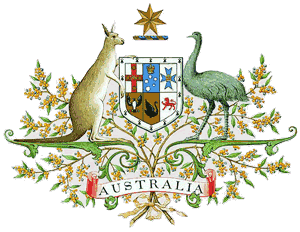

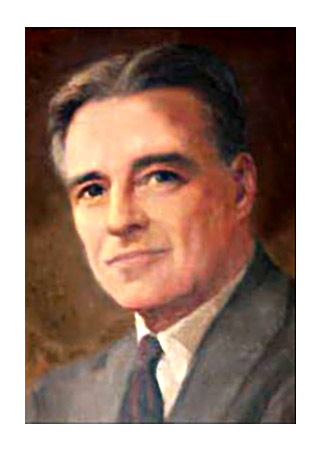 ∆ Jim Kendall (Image: Bradken)
∆ Jim Kendall (Image: Bradken)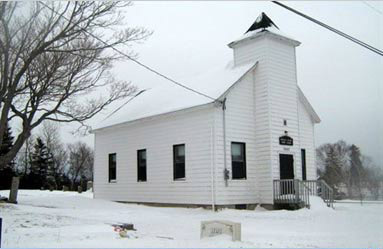 ∆ Mitchell Island Union Church, Sydney Harbour, NS, 1866. The church Kendall's grandfather helped establish. Although it could be used by any preacher, it was a "preaching station" for the North Sydney Calvary Baptist Church.
∆ Mitchell Island Union Church, Sydney Harbour, NS, 1866. The church Kendall's grandfather helped establish. Although it could be used by any preacher, it was a "preaching station" for the North Sydney Calvary Baptist Church.
